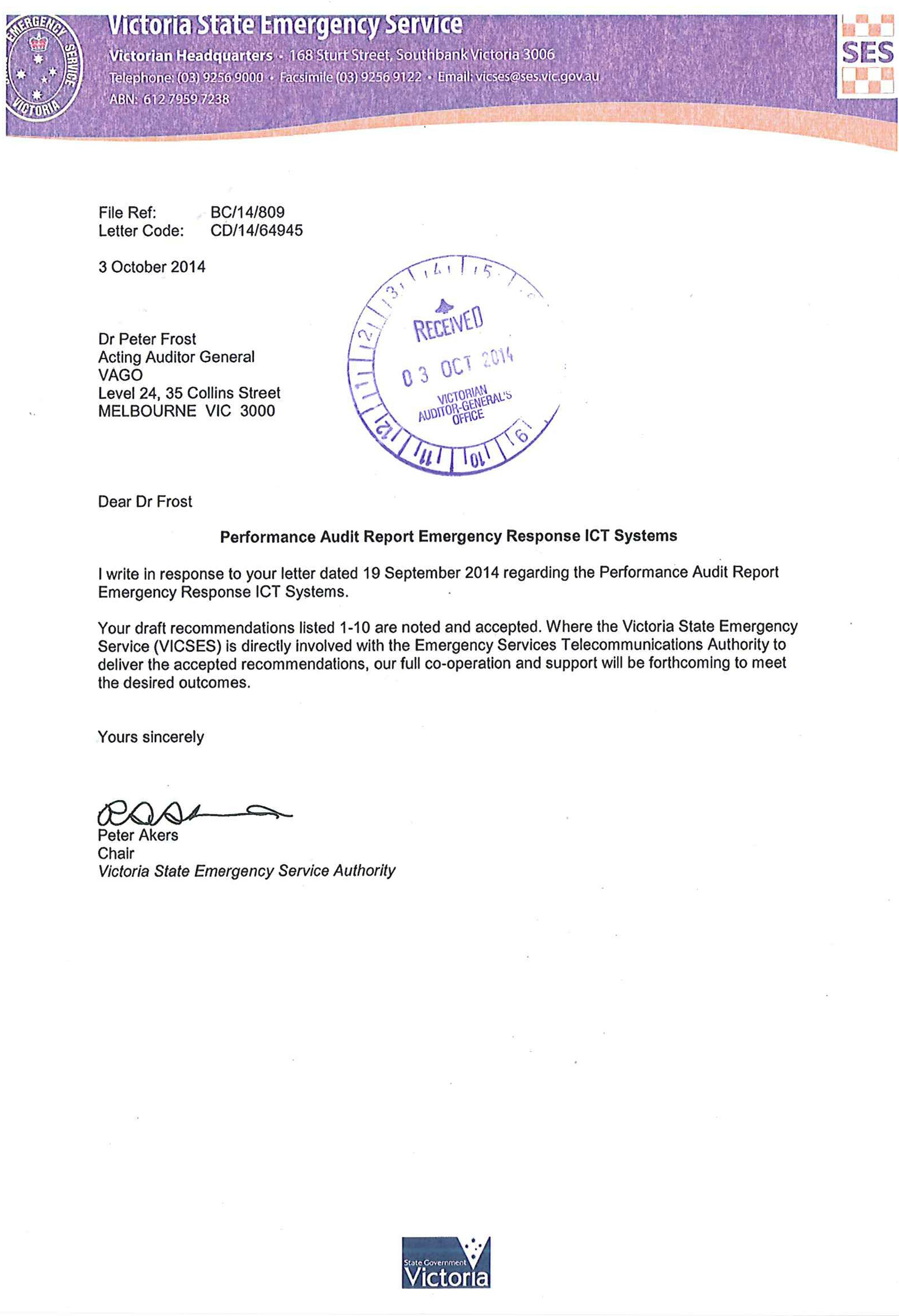Emergency Response ICT Systems
Overview
Victorians rely on emergency services organisations during emergencies and crisis incidents, and expect a prompt and efficient response to any emergency.
This audit assessed how Information and Communications Technology systems and processes are used to deliver an emergency service response.
The Emergency Services Telecommunications Authority (ESTA) plays a critical role by taking calls for emergency assistance and dispatching emergency service resources to an incident. Performance is measured against Inspector-General for Emergency Management determined standards.
The audit found that when all systems are working, ESTA is meeting call-taking standards but is consistently failing to meet its emergency ambulance dispatch standards.
A computer aided dispatch system (CAD) is central to ESTA’s operations. However, when CAD fails, the backup manual card-based process is inadequate.
The audit also found that, except for the StateNet Mobile Radio rural communications network, radio systems are modern with up to date technology. However, police channels on the Metropolitan Mobile Radio network can become congested at peak times and when Protective Service Officers are on duty at railway stations.
A modern data network is installed in all metropolitan ambulances, but only 30 per cent of operational police vehicles.
A new digital radio network for the Country Fire Authority is operating satisfactorily, but should be extended to all other emergency service organisations to overcome the limitations of the analogue rural network.
Emergency Response ICT Systems: Message
Ordered to be printed
VICTORIAN GOVERNMENT PRINTER October 2014
PP No 369, Session 2010–14
President
Legislative Council
Parliament House
Melbourne
Speaker
Legislative Assembly
Parliament House
Melbourne
Dear Presiding Officers
Under the provisions of section 16AB of the Audit Act 1994, I transmit my report on the audit Emergency Response ICT Systems.
The audit assessed whether emergency response information and communications technology systems were meeting the service delivery expectations of emergency services organisations, providing services in an effective and efficient manner to optimise the dispatch and management of emergency resources, and whether these systems were being maintained and upgraded in an effective and timely manner.
The audit examined 11 public sector agencies including the Emergency Services Telecommunications Authority (ESTA), all the emergency services organisations, as well as their portfolio departments.
I observed that ESTA is an organisation under some stress. It is currently receiving an emergency call on average every 13 seconds with demand growing at approximately 3 per cent each year. Its computer aided dispatch system has had a recent history of failure and is not sufficiently resilient or reliable for the role it is expected to perform. I note that the computer aided dispatch system is about to be upgraded.
I have made 10 recommendations aimed at addressing issues identified in the audit. Each agency with a recommendation has committed to implementing these improvements.
Yours faithfully

John Doyle
Auditor-General
14 October 2014
Auditor-General's comments
 John Doyle Auditor-General |
Audit team Paul O’Connor—Engagement Leader Wayne Singleton—Team Leader David English—Senior analyst Annie Skelton—Analyst Engagement Quality Control Reviewer Ray Winn |
On a daily basis, Victorians rely on police, fire, ambulance and other emergency services organisations to respond to emergency incidents that may range from critical medical emergencies to fires, road, rail and air accidents, or storm damage to homes and infrastructure.
Our emergency services organisations are required to be appropriately responsive to a broad range of events. Their information and communications technology (ICT) systems need to be sufficiently reliable and available to ensure they can operate effectively.
This audit considered the processes and systems used from when an emergency call is received by the Emergency Services Telecommunications Authority (ESTA), until the successful dispatch of an emergency responder unit.
ESTA's critical ICT systems include a Computer Aided Dispatch (CAD) system and a number of voice and data communications networks, along with their supporting infrastructure.
Provided that all ICT systems are working satisfactorily, I found that ESTA is meeting its call-taking performance standards and its non‑emergency dispatch standards. I observed significant issues with the CAD system which has a recent history of failure and has not been upgraded because of previous industrial action.
ESTA is meeting its emergency dispatch performance standards for police and fire services but it has not met its ambulance emergency dispatch standards over the past three years because of issues with some ESTA procedures and staffing.
I also noted that ESTA is failing to predict the likely increase in demand for call‑taking during major incidents. This leads to calls being queued and a consequential delay in the dispatch of responder units.
ESTA will be challenged to meet its performance standards, given the growth in demand for its services is currently 3 per cent each year. This is concerning.
While most radio systems and their supporting networks use modern technology provided under contract by third parties, I observed that certain metropolitan police channels become congested during periods of high demand and when protective services officers are on duty at railway stations.
The unsecure nature of the legacy rural radio network is a safety risk for police as it can be easily monitored by radio scanners. A new digital network in use by the Country Fire Authority would address most of this network's shortcomings, if it was extended to other emergency response organisations.
I am pleased to note that all agencies involved have accepted their applicable recommendations and have indicated specific courses of action in their responses.
I would like to thank each of the agencies for their assistance and cooperation during the course of this audit.

John Doyle
Auditor-General
October 2014
Audit Summary
Victorians rely on the state's emergency services organisations (ESO) for assistance during emergencies and crisis incidents and expect a prompt and effective response.
In Victoria, all Triple Zero calls are forwarded to a single organisation, the Emergency Services Telecommunications Authority (ESTA). ESTA is responsible for receiving emergency calls and dispatching emergency response vehicles and personnel. This centralised approach to emergency response call-taking and dispatching is unique in Australia and rare worldwide.
Processes performed by ESTA are essential and time critical and include answering the Triple Zero call and processing and dispatching the appropriate emergency response vehicle.
This audit examined the procedures and supporting information and communications technology (ICT) systems used by ESTA to answer a Triple Zero call and subsequently dispatch an emergency response vehicle.
The Victorian Auditor-General's Office will undertake a further audit this year which will examine emergency response time performance—from when a responder receives an ESTA dispatch instruction until their arrival at the incident scene.
Conclusions
ESTA is a vital element of Victoria's emergency response capabilities. It relies on the performance of ICT systems and sound processes to fulfil its role of receiving Triple Zero calls and dispatching emergency response vehicles and personnel.
ESTA currently receives an emergency call on average every 13 seconds. The number of emergency calls it receives is growing by 3 per cent each year, as is the number of emergency response vehicles it dispatches.
ESTA's performance is subject to performance standards published by the Inspector‑General for Emergency Management (IGEM), who makes the determination after consultation with each of the ESOs. These standards apply to the response time to answer an incoming call and the total time taken to send dispatch instructions to an emergency responder.
When all ICT systems are working, ESTA is meeting its call-taking performance standards and its non-emergency dispatch standards. It is also meeting its required emergency dispatch standards for police and fire services but has consistently failed to meet its ambulance emergency dispatch standards over the past three years. The findings of this audit focus on areas for improvement.
It is difficult to see how ESTA can meet the expected growth in demand for its services, given the limitations imposed by current ICT systems and the available backup arrangements.
During equipment outages or major events such as heatwaves, bushfires or floods, ESTA has difficulty meeting its performance standards. ESTA's ability to predict the likely increase in demand for emergency services is key to its performance during major events. If it cannot precisely predict demand and the number of call-takers and dispatchers required, calls can queue up, resulting in delays to emergency call-taking and the dispatch of emergency vehicles.
ESTA has well implemented and coordinated decision processes and procedures to reconfigure call queues and optimise work practices to accommodate additional staff to meet the increased demand associated with major events. There is, however, a limit to ESTA's ability to expand its capacity and this was acknowledged by the 2009 Victorian Bushfires Royal Commission. If, in addition, there was an ICT system failure during such events, there could be a significant effect on the emergency services' ability to respond to an emergency.
The current version of ESTA's Computer Aided Dispatch (CAD) system has a history of failures, is currently using outdated software and there are limitations to the communications network supporting the CAD system. While funding had previously been approved to upgrade the CAD system, it is only now being upgraded because past industrial action halted training of existing staff.
ESTA's call-taking and dispatch services were disrupted five times in the past 18 months by technical failures or issues relating to the CAD system. On these occasions the only alternative is a manual card-based process. ESTA's performance when the manual process is activated is unsatisfactory and directly impacts the time‑critical nature of ESTA's and the ESO's activities.
None of these failures occurred during periods of high demand. However, activating the manual card-based process does impact on ESO response times.
The communications systems used for emergency management range from the latest digital technology to older analogue networks which are mainly used in regional areas. The Metropolitan Mobile Radio (MMR) network performs well at a technical level but suffers from congestion on certain Victoria Police (VicPol) channels due to the volume of voice traffic on these channels from operational police and protective services officers (PSO) each evening. The StateNet Mobile Radio (SMR) network used by all rural emergency responders and the Victoria State Emergency Service (VicSES) is unsatisfactory when compared to the performance of the MMR network.
Findings
Emergency Management Victoria
The Emergency Management Act 2013 (the Act) describes Emergency Management Victoria (EMV) as being responsible for major emergencies involving, for example, significant fires, floods or storms. These major emergencies represent a significant but small part of the day-to-day operations of ESOs. Under the Act, EMV is also responsible for interoperability between the ESOs. EMV is a portfolio agency of the Department of Justice.
The Act does not include Ambulance Victoria (AV) and makes specific reference to ESTA only in relation to the strategic action plan. It is unclear how EMV will meet its legislated responsibilities for ensuring interoperability between ESTA and the ESOs when these organisations are not part of EMV's mandate.
Performance standards
The Emergency Services Telecommunications Authority Act 2004 requires IGEM to determine quantitative and qualitative standards for the call-taking and dispatch services it provides to ESOs. This includes time-based performance measures such as the speed of call answer and the time to dispatch resources to events.
These quantitative standards are averaged over the month, providing a cumulative result that is reported to IGEM monthly.
The qualitative measures that focus on call-taker and dispatcher information quality relate to matters such as the appropriateness and accuracy of information. Typically ESOs expects ESTA to reach a level of compliance—for example, for ambulance services the required accuracy by a dispatcher forwarding event information is 97.6 per cent.
Meeting service delivery expectations
ESTA is not meeting the day-to-day performance objectives for metropolitan emergency ambulance dispatches and is not initiating dispatch instructions within agreed time frames. ESTA is required to achieve 90 per cent of metropolitan ambulance dispatches within the designated 150 seconds. During 2013–14 it did not achieve this target in any month. This has a significant impact on AV response times and ability to meet its key performance indicators. There is no currently agreed performance standard for rural ambulance dispatch.
ESTA has difficulty meeting performance objectives during major events, such as storms, due to problems in predicting likely call volumes. This results in calls being queued and long delays in the dispatch of an emergency responder.
The standards for ambulance and police are largely unchanged since ESTA commenced operations on 1 July 2005. The standards for the Metropolitan Fire and Emergency Services Board, the Country Fire Authority and VicSES have had significant revisions in 2009 and 2010 following the Black Saturday fires.
There have been a number of other emergency responder based changes since, but these have not been reflected in the IGEM standards. An example is the introduction of the 'aspirin protocol', which is intended to assist the survival rates of heart attack victims. This change has added up to 30 seconds to the ambulance call-taker process which can impact dispatch time but has not been reflected in changes to ESTA's ambulance performance standard.
While there is a review process between ESTA and the ESO wishing to make a change, this needs to be improved to ensure IGEM is involved and the costs, benefits and operational impacts of these changes are fully accounted for prior to them being offered to IGEM for determination.
ICT system performance
Emergency response ICT systems have significant performance, reliability and availability limitations which are impacting day-to-day operations. Examples include:
- MMR channels assigned to police activities are congested when PSOs are on duty and during periods of peak demand for police services.
- The SMR network used by ESOs is an unsecure, analogue network using old technology and does not perform well when compared to the modern MMR network. Of particular concern is the lack of security for police, because sensitive information from the Law Enforcement Assistance Program (LEAP) is being transmitted without any encryption and can be easily monitored by the public.
- Significant problems arise when ESTA's CAD system fails and operations revert to a manual process, resulting in delays in information being provided to dispatchers and the transfer of events to the AV referral service—REFCOMM. This impacts the ability of emergency responders to achieve their target times for arriving at an incident.
- The Triple Zero telephony platform provided by Telstra and used by ESTA to receive Triple Zero calls from Telstra, is an old technology and Telstra have advised it will not be supported beyond 2015.
ESTA operates three State Emergency Communications Centres (SECC). If one or more of the SECCs were destroyed, degraded or rendered unavailable for an extended period, there would be a fundamental negative impact on the delivery of emergency service management in Victoria. The SECCs and their associated ICT systems should therefore be defined as critical national infrastructure.
Maintaining emergency response ICT systems
ESTA's physical ICT infrastructure—such as data centres, networks and power supply—is well maintained and upgraded within industry-accepted standard time frames.
ESTA's desktop systems are four to five years old, which although older than the typical industry standard of two to three years, are still performing satisfactorily.
Managed services such as MMR and ESTA's wide area network are continuously monitored with regular maintenance and upgrades built into the service contract. The SMR service appears to be well maintained, but because it is a legacy analogue radio service, no upgrade path is possible.
Although the CAD system is well maintained, it has not been upgraded in an effective and timely manner. The installed version is not current which creates supportability difficulties and has significant performance and reliability issues relating to its system architecture. ESTA has a project underway to upgrade CAD in order to address these supportability and reliability issues.
Recommendations
-
That Emergency Management Victoria be responsible for facilitating the interoperability of all organisations involved in emergency response, including the Emergency Services Telecommunications Authority and Ambulance Victoria.
-
That the Emergency Services Telecommunications Authority includes Victoria State Emergency Service vehicle capability details in the Computer Aided Dispatch database.
-
That Ambulance Victoria:
- reassesses the current structured call-taking script
- develops a single structured call-taking script for Triple Zero calls.
-
That Victoria Police implements the recommendations relating to protective services officers in the Service Demand and Dispatcher Capacity Analysis dated September 2013 and:
- works with the Emergency Services Telecommunications Authority to implement revised Metropolitan Mobile Radio channel arrangements to reduce the impact of protective services officer usage on other police users
- investigates the use of smart devices and applications for protective services officers to minimise their use of the Metropolitan Mobile Radio network for routine enquiries.
-
That Emergency Management Victoria novates the head contract for the StateNet Mobile Radio network controls to the Emergency Services Telecommunications Authority.
-
That the Emergency Services Telecommunications Authority, assisted by the Inspector-General for Emergency Management and responder agencies, improves the process for changing call‑taking and dispatch procedures by comprehensively appraising the costs, benefits and operational impacts of these changes and agreeing a plan for their implementation with all affected agencies.
-
That the Emergency Services Telecommunications Authority, assisted by Ambulance Victoria, reviews the business rules to be applied by the Emergency Services Telecommunications Authority ambulance dispatchers in selecting appropriate resources for dispatching to events, taking account of meal-break procedures.
-
That the Emergency Services Telecommunications Authority reclassifies its State Emergency Communications Centres as critical national infrastructure.
-
That the Emergency Services Telecommunications Authority critically reviews:
- the current Computer Aided Dispatch 9.1 upgrade project against business case objectives, including system and network reliability and system redundancy, once the project is completed
- the ESTA Triple Zero telephony platform telecommunications upgrade project against business case objectives, including system and network reliability once the project is completed.
-
That Emergency Management Victoria expedites the expansion of the Rural Mobile Radio network to all emergency services organisations.
Submissions and comments received
In addition to progressive engagement during the course of the audit, in accordance with section 16(3) of the Audit Act 1994 a copy of this report, or relevant extracts of this report, was provided to the following agencies with a request for submissions or comments:
- Ambulance Victoria
- Country Fire Authority
- Department of Environment and Primary Industries
- Department of Health
- Department of Justice
- Emergency Management Victoria
- Emergency Services Telecommunications Authority
- Inspector-General for Emergency Management
- Metropolitan Fire and Emergency Services Board
- Victoria Police
- Victoria State Emergency Service.
Agency views have been considered in reaching our audit conclusions and are represented to the extent relevant and warranted in preparing this report. Their full section 16(3) submissions and comments are included in Appendix F.
1 Background
1.1 Introduction
Victorians rely on the state's emergency services organisations (ESO) for assistance during emergencies and crisis incidents, and expect a prompt and efficient response. Emergency response is not just about combating major disasters or events like bushfires, heatwaves and widespread flooding. It is also about an ongoing requirement to provide emergency assistance to members of the Victorian public on a daily basis by dispatching police, fire, rescue, ambulance or other emergency services.
The Emergency Services Telecommunications Authority (ESTA) plays a critical role in this by answering emergency calls and dispatching the appropriate emergency response. In 2013–14, ESTA answered an emergency call, on average, every 13 seconds.
The federal government has initial responsibility for answering emergency calls from the public. Telstra provides this service as a condition of its telecommunications licence and answers Triple Zero and 112—the international default mobile emergency number—calls on a national basis and then transfers them, with any associated caller identification information, to the relevant ESO in each state or territory. In Victoria, these calls are transferred to ESTA.
ESTA receives all emergency calls for assistance and also receives non-emergency calls such as requests for non-urgent ambulance transport and patient transfer, as well as notification by the public or other organisations of planned burns to reduce the amount of fuel available to potential bushfires. ESTA is also responsible for the dispatch of appropriate ESO resources to both emergency and non-emergency events as required.
Victoria's centralised approach to call-taking and dispatching of emergency response is unique in Australia and rare worldwide.
1.2 Emergency management in Victoria
1.2.1 Changes to emergency management arrangements
Since the 2009 bushfires and the 2010–11 and 2012 floods which severely impacted many areas of Victoria, the government has implemented a number of reforms in emergency management. The government released a white paper Victorian Emergency Management Reform in December 2012 which set out new arrangements for the management and governance of emergency response.
On 1 July 2014, the Emergency Management Act 2013 (the Act) came into force. It established new governance arrangements for emergency management, repealed the Fire Services Commissioner Act 2010 and consequentially amended other emergency management legislation.
1.2.2 Emergency Management Victoria
Emergency Management Victoria (EMV) was established under the Act as the overarching body for emergency management in Victoria. EMV is responsible for coordinating ESOs, including day-to-day interoperability between agencies, and publishing prescribed response standards for each ESO to arrive at the scene of an emergency.
EMV is also responsible for emergency management planning and for coordinating ESOs with control responsibility for major fires, floods or other major emergencies.
These duties require the Emergency Management Commissioner (EMC) to coordinate relief and recovery efforts—including social, economic, built infrastructure and environmental impacts—and manage their escalation.
The Act does not include Ambulance Victoria (AV) and makes specific reference to ESTA only in relation to the strategic action plan. However, the State Emergency Response Plan gives AV responsibility for providing the operational health response to major incidents. AV is a Department of Health (DOH) portfolio organisation, unlike most other ESOs, which are Department of Justice (DOJ) portfolio organisations.
1.2.3 Inspector-General for Emergency Management
The Inspector-General for Emergency Management (IGEM) was established on 1 July 2014 under the Act and supersedes the former Office of the Emergency Services Commissioner.
IGEM is responsible for:
- developing and maintaining an emergency management monitoring and assurance framework
- monitoring and reporting to the Minister for Police and Emergency Services on the implementation of the strategic action plan by:
- responder agencies
- departments
- ESTA
- EMV.
1.3 Emergency services organisations
The ESOs that provide emergency response services are:
Victoria PoliceVictoria Police (VicPol) operates under the Victoria Police Act 2013 and provides policing services to the Victorian community. When required, VicPol works in conjunction with other ESOs and government departments in the area of emergency management. |

Photograph courtesy of ChameleonsEye/Shutterstock.com. |
|
Ambulance VictoriaAV was established on 1 July 2008 and is a portfolio agency of DOH. AV aims to improve the health of the community by providing high-quality pre-hospital care and medical transport. As an ESO, it is responsible for responding to medical-related emergencies across the state. |

Photograph courtesy of Ambulance Victoria. |
|
Metropolitan Fire and Emergency Services BoardThe Metropolitan Fire and Emergency Services Board (MFB) delivers fire and emergency management services across predefined boundaries within metropolitan Melbourne. It responds to fire emergencies, fire alarm call-outs, road rescues, urban search and rescue, and also assists other ESOs as requested. MFB also supports AV—providing additional medical responder services for life-threatening situations. |

Photograph courtesy of the Metropolitan Fire and Emergency Services Board. |
|
Country Fire AuthorityThe Country Fire Authority (CFA) is a volunteer and community-based fire and emergency services organisation and includes career fire fighters on its staff. It has evolved from informal beginnings in community-based fire brigades to become one of the world's largest volunteer-based emergency services organisations. |

Photograph courtesy of the Country Fire Authority. |
|
Victoria State Emergency ServiceVictoria State Emergency Service (VicSES) is a volunteer-based organisation providing emergency assistance to the community 24 hours a day, seven days a week. It is the control agency during emergency responses to floods, storms, earthquakes and tsunamis across Victoria. It is also the largest provider of road rescue services in the state. VicSES also assists VicPol in search and rescue operations, and plays an important support role during major bushfire responses. |

Photograph courtesy of Victoria State Emergency Service. |
1.4 Emergency Services Telecommunications Authority
ESTA is a statutory authority created under the Emergency Services Telecommunications Authority Act 2004. Its role is to receive all emergency calls intended for Victorian ESOs and to dispatch the appropriate services to emergencies.
ESTA operates three interconnected State Emergency Communications Centres (SECC) located in East Burwood, Docklands and Ballarat, from which it answers emergency calls and dispatches ESOs to events.
ESTA's role in regards to EMV is not specified, although EMV is required to advise on matters relating to ESTA as part of its role under the Act to provide reports to the State Crisis and Resilience Council.
1.5 Managing emergency service calls
Telstra answers Triple Zero calls nationally and all calls relating to emergency events in Victoria are transferred directly to ESTA as either a police, fire or ambulance call.
A call priority system is used to assign an appropriate priority to the call based on its source. Triple Zero calls are given the highest priority to ensure they are always answered by the next appropriate and available call-taker.
Figure 1A describes the different types of emergency and non-emergency calls taken by ESTA.
Figure 1A
Sources of ESTA emergency and non-emergency calls
|
Type of call |
Source |
|---|---|
|
Triple Zero emergency calls transferred by Telstra |
Originates from landline or mobile phone and is the primary method of getting an ESO to an emergency situation. |
|
112 emergency calls transferred by Telstra |
Originates from mobile phones as an alternative to Triple Zero. 112 is the internationally recognised emergency call number under the International Telecommunication Union Global System for Mobile Communications mobile phone standard. |
|
1300 calls directly from police stations and police members |
Most police stations have a 'hotline' to ESTA for emergencies reported directly to police stations. Police members also have a 1300 number to report events or any emergencies they may encounter. |
|
106 (Emergency Call) |
Relay service for deaf and speech impaired people. Calls are received by the National Relay Service centre and forwarded to ESTA as a voice Triple Zero call. |
|
Alarms, including fire and monitored security alarms |
Originates from third party alarm monitoring service providers. |
|
132 500 SES emergency calls |
Originates from landline or mobile phone for assistance with flood, storm, tsunami or earthquake incidents. Calls initiated in Victoria are automatically forwarded directly to ESTA. |
|
Non-emergency ambulance calls |
Originates from appropriate health professionals such as registered medical practitioners for patients requiring assistance while being transported. Any such request relates to a non-emergency ambulance required at a future time. |
|
Planned burn calls |
Originates from persons calling to advise of their intention to burn off grass, stubble, weeds, undergrowth or other vegetation outside the designated fire danger period. |
|
Calls from external agencies |
Airports, CityLink, public transport operators, VicRoads, Port of Melbourne Corporation, etc. calls for assistance. |
Source: Victorian Auditor-General's Office
1.5.1 Incoming call queuing arrangements
ESTA's incoming call activities are managed through a call queuing system which normally has a separate queue for police, fire, ambulance or VicSES calls. ESTA's call‑taking process is shown in Figure 1B.
Figure 1B
ESTA call-taking process
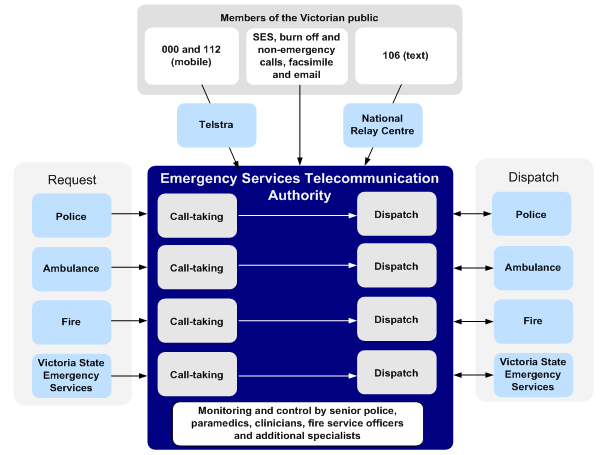
Source: Victorian Auditor-General's Office.
Each queue is serviced by a team of ESTA call-takers who establish the nature of the emergency and determine the type of response required at the incident. This key information is recorded in the Computer Aided Dispatch (CAD) system as an 'event' and is then released for dispatch.
ESTA dispatch operators are allocated to either police, VicSES, fire or ambulance to dispatch appropriate resources as required and to manage events.
Each dispatch operator has responsibility for dispatching the relevant ESO responder to an event using the CAD system and communicating with the ESO units through:
- voice—telephone or radio
- mobile data terminals—if fitted in vehicles
- pagers—if carried by responders.
Dispatchers also oversee the safety of operational police, ambulance, fire and VicSES responders and provide a communications link for any requests from them for further resources or information.
1.6 Critical ICT systems
A range of information and communications technology (ICT) systems enable ESTA and the ESOs to fulfil their respective responsibilities. Most of these systems are managed by ESTA on behalf of the state, while others are provided by DOJ, the Department of Environment and Primary Industries (DEPI), CFA and AV. The primary ICT systems and their interrelations with ESTA and the ESOs are shown in Figure 1C.
Figure 1C
Primary communications networks used by ESTA to manage ESOs
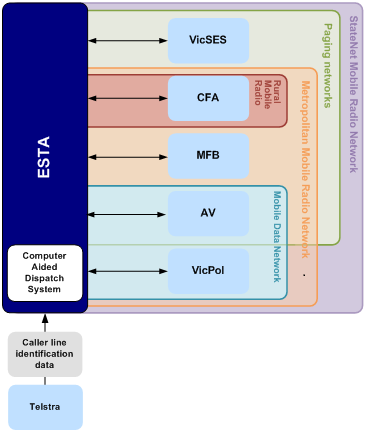
Note: Paging networks include the Emergency Alerting System (EAS) and a commercial provider supplementing the EAS for Ambulance Victoria.
Source: Victorian Auditor-General's Office.
Computer Aided Dispatch system
The core of ESTA's ICT systems is the CAD system, which has call-taking and dispatch functionality and holds current and historical data relating to emergency response events.
Purpose-built communications networks
ESTA uses purpose-built communications networks to support the needs of each ESO. These are defined as either 'mission critical' or 'business critical' systems. Mission critical systems are systems whose failure will result in the failure of business operations or adversely impact service delivery. Business critical systems are those which would have a significant impact on business operations should they fail.
The communications systems in use are:
|

Photograph courtesy of the Victoria Auditor-General's Office. |
|

Photograph courtesy of the Victoria Auditor-General's Office. |
|

Photograph courtesy of the Victoria Auditor-General's Office. |
|

Photograph courtesy of the Victoria Auditor-General's Office. |
|

Photograph courtesy of CFA Strategic Communications. |
1.6.1 Call-taking and dispatch demand growth
During the 2013–14 financial year, ESTA answered more than 2.4 million calls, or on average one call every 13 seconds, and dispatched resources to approximately 2 million events.
Annual call volumes are growing by more than 5 per cent and dispatches by 4 per cent as shown in Figure 1D. During the period prior to 2012–13 the growth figures include the introduction into ESTA of call-taking and dispatch services previously provided by AV and VicPol. Since then annual growth in call-taking and dispatch demand is increasing at approximately 3 per cent per year.
Figure 1D
ESTA call taking and dispatch volumes by financial year
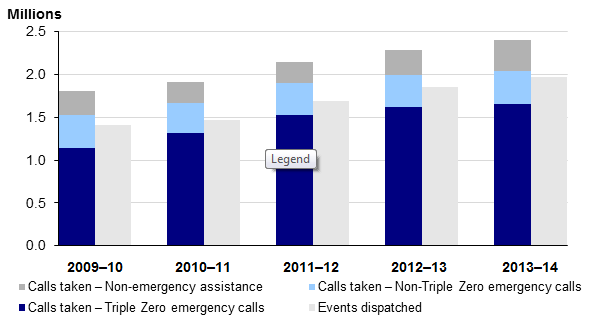
Source: Victorian Auditor-General's Office based on information from Emergency Services Telecommunications Authority data.
1.6.2 Workload management
ESTA has a workload estimation/forecasting system, using historical call data relating to time of day, day of the week, special events and other factors, to assess the number of call-takers required to meet forecast queue demands on any given day.
ESTA schedules its call-takers according to this predictive data. A real-time input of actual call volumes is then applied every 15 minutes which ESTA uses to align available resources to demand.
If there is an unpredicted surge in the number of emergency calls, ESTA can re-task appropriately qualified staff from training and administration duties to increase the number of call-takers at short notice.
During a surge, ESTA has the ability to electronically reconfigure call queues by either combining or splitting these to better manage demand. For example, during a significant storm in late June 2014, the combined police and VicSES call queues reverted to their separate queues.
The dispatch workload is typically managed by the provision of dedicated dispatchers for police, fire, ambulance and VicSES.
It is common during a surge event for the three ESTA SECCs to be reconfigured to optimise call-taker and dispatcher arrangements to improve response times and meet required performance standards.
Where an increase or decrease in dispatcher demand is experienced, ESTA is also able to merge or split radio channels to better manage demand. This capability is not available for regional emergency ambulance communications.
1.7 Previous relevant performance audits
A previous Victorian Auditor-General's Office report related to this audit was Obsolescence of Frontline ICT: Police and Schools, which was tabled in June 2012 and found that ESTA had effectively managed obsolescence risks for the MDN.
It also found that the MDN contractor had performed well against demanding performance measures, and that the system had, through a range of modifications, evolved to meet changing operational needs. There were no specific recommendations relating to the MDN.
1.8 Audit objective and scope
The objective of this audit was to assess the reliability, capacity, resilience and effectiveness of emergency management ICT systems and processes used to receive calls for assistance and then dispatch and manage emergency resources at incident scenes.
Aspects specifically examined included voice and data systems, as well as relevant business processes.
The audit examined whether emergency ICT systems were:
- meeting the service delivery expectations of ESOs
- providing services 24 hours a day, seven days a week, in an effective and efficient manner to optimise the dispatch and management of emergency resources allocated to incidents during periods of normal operations or during equipment outages or security incidents
- being maintained and upgraded in an effective and timely manner.
The audit examined the main agencies responsible for critical emergency response and those frontline services that provide Victoria's emergency response capabilities. These were:
- DOJ—which is the portfolio department for all ESOs except for AV.
- DOH—which is the portfolio department for AV.
- DEPI—which has responsibility for fire and other emergencies on public land
- ESTA—which receives all emergency calls intended for Victorian ESOs and dispatches appropriate services to emergencies.
- EMV and its predecessor, the Fire Services Commissioner Victoria—which is responsible for implementing the government's emergency management reform agenda and for oversight of most major emergency events.
- IGEM and its predecessor, the Office of the Emergency Services Commissioner—which is responsible for determining the standards for ESTA and monitoring and investigating ESTA's performance.
The audit also examined a selection of ESOs with a focus on rural police, fire and ambulance services and how ICT systems and procedures were implemented to dispatch and manage emergency incidents. These ESOs were:
- AV
- VicPol
- CFA
- VicSES
- MFB
1.9 Audit method and cost
The method for this audit included an examination of documents and interviews with staff at agencies subject to the audit. We also used other official documents and published available research.
The audit team attended and observed operations in each of the ESTA SECCs during normal operations and during one major storm event. The team also visited ESOs in metropolitan and rural locations.
The audit was performed in accordance with the Australian Auditing and Assurance Standards. Pursuant to section 20(3) of the Audit Act 1994, unless otherwise indicated any persons named in this report are not the subject of adverse comment or opinion.
The cost of the audit was $500 000.
1.10 Structure of the report
The report is structured as follows:
- Part 2 examines whether ESTA is meeting service delivery expectations.
- Part 3 examines whether ESTA is dispatching and managing emergency resources effectively.
- Part 4 examines whether emergency response ICT systems are being maintained and upgraded effectively.
2 Meeting service delivery expectations
At a glance
Background
The Emergency Services Telecommunications Authority (ESTA) call-taker and dispatch performance standards are determined by the Inspector-General for Emergency Management (IGEM) after consultation with ESTA and each emergency service organisation (ESO).
Conclusion
ESTA is not meeting some of the performance standards determined by IGEM, even during periods of normal operations when demand is predictable. ESTA's ambulance dispatch performance is consistently not meeting performance standards. ESTA also has difficulty meeting performance standards during major unplanned events due to call volume prediction issues and during periods of equipment failure, when a manual card-based process is used.
Findings
- ESTA is meeting call-taking performance standards for ESOs when its activities are normal. It has difficulties with the dispatch performance for emergency ambulance in particular and has not met this standard for three years.
- Metropolitan police radio networks experience congestion during peak activities.
- The rural radio network is not satisfactory when compared to the modern metropolitan network. Its lack of security is a safety risk for police and the community.
Recommendations
- That Emergency Management Victoria (EMV) becomes responsible for facilitating the interoperability of all organisations involved in emergency response.
- That ESTA, assisted by IGEM, improves the process for changing call-taking and dispatch procedures where these impact ESTA's performance standards.
- That Victoria Police implements the recommendations relating to protective services officer communications, as detailed in its September 2013 analysis.
- That EMV novates the StateNet Mobile Radio network head contract to ESTA.
- That Ambulance Victoria reassesses the current structured call-taking script.
2.1 Introduction
The time taken from a caller requesting assistance until the arrival of the first responder unit at the scene is an important aspect of emergency response. These elapsed times include, in part, the time taken by the Emergency Services Telecommunications Authority (ESTA) to answer each call and dispatch the appropriate responder.
The achievement of these performance objectives is one of ESTA's key performance indicators (KPI). Other KPIs include the completeness of information provided by call-takers and dispatchers and the responsiveness of communications between ESTA dispatchers and emergency services organisations (ESO) responder units.
If ESTA doesn't achieve its response standards, there is likely to be an impact on the timely arrival of an emergency responder to an incident and this could pose a risk to the safety and wellbeing of the public.
This Part examines whether emergency response information and communications technology (ICT) systems and processes are meeting the service delivery expectations of the ESOs.
We assessed this by analysing data from the ESTA Computer Aided Dispatch (CAD) system, observing call-taker and dispatch activities at the three ESTA State Emergency Communications Centres (SECC) and conducting interviews and visits with staff from each ESO.
2.2 Conclusion
ESTA is not meeting the performance objectives for dispatching emergency ambulances and Victoria State Emergency Service (VicSES) vehicles and is not dispatching responder units within agreed time frames.
Critically, ESTA has difficulty meeting performance objectives during major unplanned incidents, such as storms, due to problems in predicting likely call volumes and resource requirements. This can result in delays in calls being answered and emergency units being dispatched during a time of high demand and stress across the community.
There are also problems during periods when the CAD system is unavailable and ESTA activates a manual card-based process. This has occurred on five occasions over the past 18 months.
Dispatchers are also impacted when CAD fails, as computer aided decision tools—such as incident mapping and crew location tracking—are severely degraded during such an outage. This makes it difficult for a dispatcher to assign the correct vehicle or resource to an incident through an informed assessment.
Some emergency response radio systems have performance, reliability and availability limitations which are impacting operations. Examples include:
- Certain Metropolitan Mobile Radio (MMR) channels assigned to police activities can become overloaded during evening periods when protective services officers (PSO) are on duty and during peak demand periods for police services. This can result in ESTA and these police and PSO units being unable to easily communicate due to radio channel congestion.
- The StateNet Mobile Radio(SMR) network used by rural ESOs is an unsecure, analogue network which does not perform well when compared with the modern MMR system in terms of coverage and voice quality. This results in difficulties and delays in getting instructions to and from units, which can also trigger safety issues. Operational security is a particular safety issue for police. Smartphone applications or portable radio scanners can easily listen in to these unsecure communications, which often include the voice transmission of sensitive data extracted from the Law Enforcement Assistance Program (LEAP).
2.3 Emergency Management Act 2013
Emergency Management Victoria (EMV) has a coordination role which includes interoperability arrangements between agencies. It publishes prescribed response standards and incident management operating procedures to facilitate this responsibility.
The Emergency Management Act 2013 (The Act) does not include Ambulance Victoria (AV) and makes specific reference to ESTA only in relation to the strategic action plan. It is unclear how EMV will meet its legislated responsibilities for coordinating interoperability between ESTA and the ESOs when these organisations are not part of EMV's mandate.
The audit found that EMV should take responsibility for facilitating interoperability between all ESOs. While this may be an issue for AV whose portfolio department is the Department of Health and for the Department of Environment and Primary Industry (DEPI) which has particular responsibilities for public lands, it should not detract from EMV's responsibilities across all ESOs.
2.4 Inbound call queue management
ESTA is required to answer incoming calls within a prescribed time period. ESTA is answering calls as efficiently as the currently installed technology allows. The call queuing system works satisfactorily within the limits of its capabilities, however, it is built upon now obsolete 1980's technology.
The supplier of the equipment is having increasing difficulty in providing support, which will cease in December 2015. As a consequence of this, funding has been approved for a replacement system.
ESTA operates three SECCs which are located at Tally Ho Business Park (THO) in East Burwood, Mount Helen in Ballarat (BAL) and the World Trade Centre (WTC) in Docklands. Call-taking and dispatch activities are distributed across these SECCs as shown by Figure 2A.
Figure 2A
ESTA call-taker locations
|
Call-takers and dispatchers |
WTC SECC |
BAL SECC |
THO SECC |
|---|---|---|---|
|
Police and VicSES |
✔ |
✔ |
|
|
Ambulance |
✔ |
✔ |
|
|
Fire |
✔ |
✔ |
Source: Victorian Auditor-General's Office.
Calls come to ESTA and are queued according to the type of response requested by the caller. Normally operations have a queue for police—which also services the VicSES queue—and a queue each for fire and ambulance. Specialist police, fire or ambulance call-takers are located at the SECCs as shown in Figure 2A, and are allocated the next call in their queue, irrespective of their SECC location
Call management during periods of high demand
During periods when there is a surge in calls, ESTA adjusts inbound call handling by combining and/or splitting queues to better manage demand. When a queue is split, an additional call-taker is positioned to join the additional queue.
ESTA's objective is for minimal calls to be held in queues. When call queues become too long ESTA has procedures to change its recorded voice message to guide callers to other options. This feature is normally only required during extreme events.
The number of call-takers required at any point in time is based on historical data provided from the ESTA workforce management system—including seasonal effects, holidays, and one-off changes in the ESTA and ESO operating models.
ESTA adjusts the workforce management system to take into account the predicted number of calls, and then manages call queues and the number of call-takers to attempt to maintain required standards.
An example of how major events change ESTA's fundamental operational activities was observed by the audit team during a recent major storm event. The key points are included in the case study in Figure 2B, and are described in detail in Appendix C.
Figure 2B
Case study—major storm event
|
During major storms from 22–24 June 2014, ESTA correctly estimated likely call traffic for the 23 June 2014 events, but underestimated the number of calls likely to be received in the police emergency and VicSES non-emergency queues on 24 June 2014, which was the worst day of the storms. As a result, ESTA did not activate all of its available call-takers and some queuing of calls occurred. On 24 June 2014, at the peak of the storm event, queue lengths reached 24 calls in the police queue and 136 calls in the VicSES queue. The average time to answer a police call during the event was 14 seconds and the longest was 3 minutes and 20 seconds. The average time to answer a VicSES call was 31 seconds and the longest was 13 minutes. More details are contained in Appendix C. During the peak storm period on 24 June 2014, ESTA answered 78 per cent of calls within its performance target time of 5 seconds for police but only 17 per cent of VicSES calls within the required 20 seconds. The benchmark is to answer 90 per cent of calls within these performance target times over the entire month. 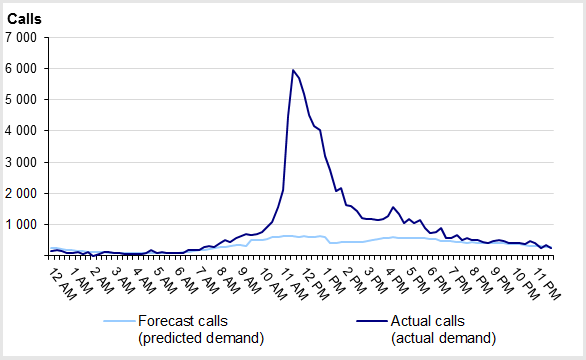
This graph shows ESTA's actual versus forecast calls received on 24 June 2014. The light blue line is the predicted call demand and the dark blue line is the actual call volumes through the call queue. |
Source: Victorian Auditor-General's Office based on Emergency Services Telecommunications Authority Computer Aided Dispatch data for 24 June 2014.
The call forecasting process needs to be reviewed. If this tool had been more accurate for this particular storm, more work stations would have been activated. The incoming call volumes for this storm illustrate the importance of developing a tool to provide more accurate forecasting.
2.5 Achievement against performance standards
The Inspector-General for Emergency Management (IGEM) determines the performance standards ESTA is required to achieve following consultation with ESTA and the ESOs. In total there are 383 individual performance values which ESTA reported its performance against during 2013–14. ESTA met 303 or 79 per cent of these values. While call-taking activities are just meeting standards, the growth in service demand of 3 per cent per annum suggests that ESTA will struggle to continue to meet its performance standards.
A similar situation exists for dispatch activities where ESTA consistently fails to meet its emergency ambulance and VicSES dispatch targets.
2.5.1 Performance standards
ESTA's performance standards consist of both qualitative and quantitative standards.
ESTA's quantitative standards are time-based and include measurements of the time taken by call-takers to answer incoming calls and also for the time taken for dispatchers to dispatch the appropriate emergency response vehicle. These standards are averaged over the month, providing a cumulative result which is reported to IGEM monthly. As an example, the performance standard for police in any month is 80 per cent of calls to be answered within 5 seconds.
In addition, there are qualitative measures which focus on call-taker and dispatcher information quality. These relate to matters such as the appropriateness and accuracy of information. Typically each agency expects a level of compliance—for example, for ambulance the accuracy required for event information forwarded by a dispatcher is 97.6 per cent.
The audit found that the qualitative targets are being met. However, the ESTA analysis process is to randomly review 50 events for each qualitative target. This is a small sample and the analysis is subjective. It is therefore of questionable value.
A detailed description of these performance standards is in Appendix A.
2.5.2 Compliance with police performance standards
ESTA is meeting police call-taking and dispatch performance targets.
Call-taking
Figure 2C shows the results of ESTA's cumulative call-taker performance for the period 1 July 2013 to 30 June 2014 across the whole of Victoria. This shows that ESTA's call‑taking for all police calls, irrespective of priority, has met the required standards each month for the period.
Figure 2C
ESTA call-taking performance for all police calls for 1 July 2013 to 30 June 2014
|
Performance target—police |
Achieved performance |
Met |
|---|---|---|
|
80 per cent of all calls answered within |
88.1 per cent of all calls answered within |
✔ |
|
95 per cent of calls answered within |
98.1 per cent of all calls answered within |
✔ |
Source: Victorian Auditor-General's Office based on Emergency Services Telecommunications Authority Computer Aided Dispatch data.
Dispatch
Performance over the period from 1 July 2013 to 30 June 2014 is detailed in Figure 2D. Further details are in Appendix D.
Events are queued to a particular police vehicle/unit operating in the area, so it is common for one unit to have several events in its queue.
At present, there are no dispatch standards for rural police events. For comparison purposes, metropolitan police standards are used by ESTA to provide IGEM with reports on its regional performance each month. This situation should be reviewed and specific rural police performance standards agreed and determined by IGEM.
Figure 2D
ESTA dispatch performance for rural police dispatches for 1 July 2013 to 30 June 2014
|
Performance target |
Metropolitan dispatch |
Rural dispatch |
Met |
|
|---|---|---|---|---|
|
Priority 1 |
80 per cent within 160 seconds |
89.5 |
91.4 |
✔ |
|
Priority 2 |
80 per cent within 300 seconds |
86.8 |
91.5 |
✔ |
|
Priority 3 |
80 per cent within 900 seconds |
98.1 |
98.4 |
✔ |
Source: Victorian Auditor-General's Office based on Emergency Services Telecommunications Authority Computer Aided Dispatch data.
Police response codes are:
- Priority 1—urgent response involving threat to life or serious injury, real or imminent danger, violence or any incident on freeways
- Priority 2—response as soon as possible for non-serious injury, offenders present or recently departed, traffic incidents in progress or VicSES request for assistance
- Priority 3—attendance is required only when a unit is available.
2.5.3 Compliance with Ambulance Victoria performance standards
In each month, ESTA is meeting ambulance call-taking performance targets. However, it is not meeting all emergency ambulance dispatch performance targets.
Ambulance response is managed through a classification system as follows:
- ERTCOM—emergency responses including Code 1 and some Code 2 responses identified during the structured call process.
- REFCOMM—some Code 2 and all Code 3 responses identified during the structured call process are passed to an AV referral service—REFCOMM—for review and action.
- NETCOM—used for non-emergency responses using contracted providers of non-emergency patient transport (NEPT) under the Non-Emergency Patient Transport Act 2003 and the Non-Emergency Patient Transport Regulations 2005.
Ambulance response codes are:
- Code 1—time-critical cases with a lights and sirens ambulance response—Priority 0 is a subset of Code 1 cases that are potentially life-threatening. Most Priority 0 cases result in co-dispatches of the nearest Metropolitan Fire and Emergency Services Board (MFB) fire unit or full-time Country Fire Authority (CFA) brigade crew where they are trained to provide life-saving first aid.
- Code 2—an acute time-critical response required within 25 minutes. The ambulance does not use lights and sirens to respond.
- Code 3—cases requiring attention within one hour.
Call-taking
ESTA met its ambulance call-taking performance standard each month over the period 1 July 2013 to 30 June 2014. The details are described in Figure 2E.
Figure 2E
ESTA call-taking performance for all ambulance calls for 1 July 2013 to 30 June 2014
|
Performance target |
Metropolitan cumulative performance (per cent) |
Rural cumulative performance (per cent) |
Met |
|
|---|---|---|---|---|
|
ERTCOM and REFCOM |
90 per cent of calls answered within five seconds |
91.3 |
91.3 |
✔ |
|
NETCOM |
90 per cent of calls answered within 30 seconds |
95.0 |
94.4 |
✔ |
Source: Victorian Auditor-General's Office based on Emergency Services Telecommunications Authority Computer Aided Dispatch data.
Dispatch performance
ESTA consistently failed to meet ambulance performance standards each month over the period 1 July 2013 to 30 June 2014 as described in Figure 2F.
Figure 2F
ESTA dispatch performance for all ambulance dispatches for 1 July 2013 to 30 June 2014
|
Classification |
Performance target |
Metropolitan cumulative performance |
Rural cumulative performance |
Met |
|---|---|---|---|---|
|
ERTCOM Code 1 |
90 per cent of events dispatched within 150 seconds |
77.6 |
75.5 |
✘ |
|
95 per cent of events dispatched within 250 second |
89.5 |
91.2 |
✘ |
|
|
ERTCOM Code 2 |
90 per cent of events dispatched within 300 seconds |
92.1 |
91.1 |
✔ |
|
95 per cent of events dispatched within 500 seconds |
89.5 |
94.1 |
✘ |
|
|
NETCOM |
Not specified by IGEM |
– |
– |
– |
Source: Victorian Auditor-General's Office based on Emergency Services Telecommunications Authority Computer Aided Dispatch data.
2.5.4 Compliance with fire service performance standards
Cumulatively over each month, ESTA is meeting fire performance targets for both call‑taking and dispatch during normal operations. However, during major events such as bushfires, performance objectives are not being met.
The first task of a call-taker is to establish the type of call. There is no structured call‑taking script for fire calls and the audit noted inconsistencies between call-takers when establishing the nature of the emergency.
![Image shows an Ambulance Victoria ambulance. Photograph courtesy of Liamdavies (Own work) [CC-BY-SA-3.0
(http://creativecommons.org/licenses/by-sa/3.0)], via Wikimedia Commons.](/reportAssets/20141014-Emergency-ICT/Image11.png)
Photograph courtesy of Liamdavies (Own work) [CC-BY-SA-3.0 (http://creativecommons.org/licenses/by-sa/3.0)], via Wikimedia Commons.
Call-taking
ESTA met its fire call-taking performance standard for 10 months over the period 1 July 2013 to 30 June 2014. The details are described in Figure 2G.
Figure 2G
ESTA call-taking performance for fire calls for 1 July 2013 to 30 June 2014
|
Classification |
Performance target |
Metropolitan cumulative performance (per cent) |
Met |
|---|---|---|---|
|
Emergency calls |
90 per cent of calls answered within |
94.0 |
✔ |
|
Operational calls |
90 per cent of calls answered within 20 seconds |
93.9 |
✔ |
|
Non-operational calls |
90 per cent of calls answered within 30 seconds |
93.9 |
✔ |
Source: Victorian Auditor-General's Office based on Emergency Services Telecommunications Authority Computer Aided Dispatch data.
During January and February 2014 when major fire incidents occurred, ESTA's performance fell to 85.2 per cent and 89.6 per cent respectively due to the significant increase in demand.
During the 2013–14 fire season there was a 36.4 per cent increase in emergency fire calls over the 2012–13 fire season.
Dispatch
ESTA's required performance for Priority 1 dispatches is that 90 per cent of rural dispatches be made within 120 seconds in country towns and within 190 seconds in other rural areas. ESTA met this target each month from 1 July 2013 to 30 November 2013.
Performance fell below the required 90 per cent in December 2013 as the fire season build up developed and ESTA also significantly underperformed during the peak fire and flood period in January and February 2014.
There was a 4.1 per cent increase in fire dispatches during the 2013–14 fire season compared to 2012–13 fire season.
CFA dispatch arrangements for volunteer brigades complicate the dispatch statistics. Because pagers are one way, ESTA has no visibility of a brigade's ability to respond until either the brigade radios that it is en-route or the prescribed eight-minute response time lapses with no radio acknowledgement from the brigade.
If the eight-minute response time lapses, ESTA then tasks another brigade to respond and the response time recommences. In effect, this could means that the fire continues to burn throughout this period, although the CFA response time is technically met.
Planned burn reporting
Outside declared fire danger periods, planned burns are permitted, provided that ESTA is advised of the details and, in certain circumstances, when a permit has been issued. During the period 1 July 2013 to 30 June 2014 ESTA received over 55 000 planned burn requests by phone.
During the audit we observed that these calls are, by their very nature, unstructured, with call-takers often having difficulty identifying the exact location of the planned burn. These are non-emergency calls which increase call-taker workloads.
Greater use of alternative forms of notification such as facsimile, email or an online form would relieve fire call-takers from this non-urgent workload.
2.5.5 Compliance with VicSES performance standards
ESTA did not meet the VicSES emergency call answer performance benchmark in most months.
Call-taking
ESTA's call-taking performance for callers requiring VicSES emergency assistance is unsatisfactory, as shown in Figure 2H. Within the combined Victoria Police (VicPol)/VicSES queue, ESTA's performance standards require it to prioritise police emergency calls as they are emergency calls with a higher priority than VicSES calls.
Figure 2H
ESTA call-taking performance for VicSES calls for 1 July 2013 to 30 June 2014
|
Classification |
Performance target |
Cumulative performance |
Met |
|---|---|---|---|
|
Emergency calls |
90 per cent of calls answered within 20 seconds |
62.7 |
✘ |
|
Non-emergency calls |
80 per cent of calls answered within 20 seconds |
82.3 |
✔ |
Source: Victorian Auditor-General's Office based on Emergency Services Telecommunications Authority Computer Aided Dispatch data.
Dispatch
There are a number of procedural issues which limit the level of coordination and support that ESTA can provide to VicSES.
Dispatch arrangements differ between road, rail, aircraft and industrial accident response and natural disasters:
- For a road rescue emergency or smaller natural events, VicSES vehicles report incident updates via radio or phone to ESTA.
- For larger natural disasters units report to their incident control centre and ESTA has only limited involvement.
ESTA is not able to task a specific VicSES vehicle as the CAD system does not hold specific vehicle information. Therefore, the vehicle responding may not be the most appropriate for the task or the closest to the incident location.
VicSES resource details should be loaded into the CAD system to assist in the efficient dispatching of appropriate vehicles.
2.6 Ambulance Victoria structured call-taking script
Significant issues were identified with the AV structured call-taking script, which appear to have contributed to an increase in AV's Priority 0 responses.
The structured call-taking script is an expert system developed in the USA which assigns a response priority to Triple Zero calls. The script provides a legally-defensible process for establishing response priority. AV is responsible for the management of this script, which is unchanged from the original, apart from minor Australianised terms.
A significant increase in AV's Priority 0 responses was first evident after an upgrade of the structured call-taking script in September 2013.
The black line in Figure 2I shows the actual Priority 0 dispatches from January 2013 to May 2014. An approximate 80 per cent rise in demand at the time of the script change is evident in the chart.
Figure 2I
Increase in AV Priority 0 dispatches during the period of the call-taking script upgrade
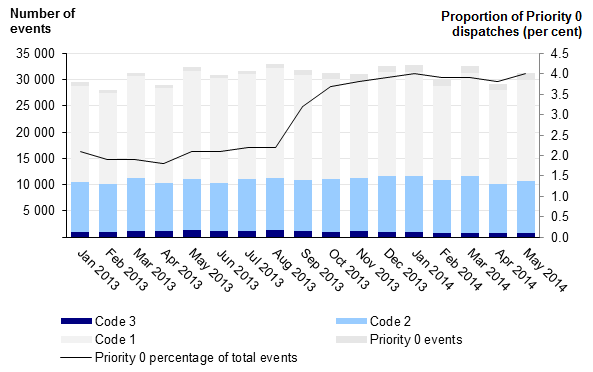
Source: Victorian Auditor-General's Office based on Emergency Services Telecommunications Authority Computer Aided Dispatch data.
The audit could not identify any other factors that could be attributed to this change. AV has advised that it is undertaking a review of this data to understand the cause of the increase.
A different AV approved structured call-taking script is used for lower priority emergency calls. Consideration should be given to a composite script covering both higher and lower priority situations.
2.7 Emergency medical call-outs
Emergency medical call-outs are when fire services are used to assist ambulances to meet arrival-at-scene objectives, but do not impact ESTA's performance objectives.
In metropolitan areas and some CFA areas covered by appropriately trained full-time crews, CFA and MFB personnel are trained to handle certain types of medical emergencies such as heart attack or breathing difficulties.
Approximately 50 per cent of Priority 0 calls, or 1 per cent of all ambulance calls for assistance in the metropolitan area, include a fire responder being co-dispatched.
2.8 Multi-agency events
VicPol, MFB, CFA, VicSES and AV routinely work together to respond to a range of emergency scenarios—such as road accidents, fires, hazardous material incidents, etc.
ESTA's emergency dispatch performance benchmarks relate to the dispatching of the first responder to the event. Where multi-agencies are dispatched to the same event, the dispatch time is the time for the first responder to be dispatched. Other services are dispatched as soon as possible after the need is identified.
2.9 Incident information accuracy, completeness and timeliness
Incident information contained in the CAD system is sufficiently accurate and detailed for ESO requirements but there are issues relating to multiple reports by the public of what may in fact be a single incident. This could result in too many or inappropriate responders being dispatched.
The over dispatch of units is usually corrected once initial responders assess the situation, and any extra units are stopped and returned. This approach is low risk and conservative, ensuring a timely response.
First responders have sufficiently accurate and detailed information to proceed to the scene with an understanding of the incident situation. The first responder at the scene is expected to provide a situation report including an assessment of any requirement for additional resources, including resources from other ESOs.
However, there is merit in ESTA investigating how the convergence of multiple calls relating to a single incident could be better identified and cross referenced.
2.10 Suitability of ICT systems
2.10.1 CAD system
Within the limits of the existing system, which is currently being upgraded, the ESTA CAD system meets most police and fire requirements.
2.10.2 Metropolitan ICT systems
The MMR radio system used in metropolitan areas is meeting the needs of police, fire and ambulance services. There are, however, congestion issues on some police MMR channels which have become increasingly evident as the numbers of PSOs has increased.
Some police and ambulance vehicles use the Metropolitan Data Network and, where vehicles are suitably equipped, the technology is satisfactorily meeting ESO requirements.
Police ICT system issues
There are significant issues relating to channel or 'talk group' congestion as police channels/talk groups are often overloaded when PSOs report for duty and carry out people and vehicle checks, which are a voice intensive radio activities for the officer as well as the dispatcher.
VicPol created a report in September 2013—Service Demand and Dispatcher Capacity Analysis—which found that the impact of additional police and PSO activity between 2 pm and 2 am was a 30 per cent increase in general police MMR calls and a 50 per cent increase in LEAP enquiries. The exact impact of PSOs alone was not measured.
The analysis included recommendations that MMR channel arrangements be refined to reduce the impact of PSO usage on other police users, and that the use of smart devices and applications for PSOs for routine enquiries should be investigated. These recommendations should be implemented by VicPol.
Approximately 30 per cent of police primary response vehicles in metropolitan areas and some rural primary response vehicles are equipped with mobile data terminals or ruggedised laptops which can request and receive CAD event information directly, including LEAP checks. This significantly reduces the ESTA dispatcher workload, and in addition, provides ESTA with accurate vehicle location information.
2.10.3 StateNet Mobile Radio
The SMR network is the primary means of voice communications between ESTA and police, ambulance and VicSES in rural areas. It is also the way that VicSES units communicate with ESTA in metropolitan areas.
The Department of Justice (DOJ) holds the head contract for the SMR network but advises that it has only limited involvement in the operational management of the contract. Each of the ESO users of the SMR—VicPol, CFA, AV, DEPI and VicSES—have their own direct contracts with the third party commercial provider of the network and therefore have responsibility for the portion of the service that they use.
ESTA uses SMR to dispatch and oversee ESO activities but is not a party to any contract with the network provider. If SMR services are disrupted, ESTA is required to contact one of the ESOs—usually VicSES—to establish whether the network is serviceable.
SMR is a mission critical network. It is unsatisfactory that ESTA, the radio control organisation, has no relationship with the network provider.
Consideration should be given to novation of the SMR head contract from DOJ to ESTA to allow it to manage the contract on behalf of the state, consistent with its current management of the MMR, Metropolitan Data Network and Emergency Alerting System (EAS) contracts.
2.10.4 Emergency Alerting System paging system
The EAS paging system is providing a satisfactory connection to all ESOs including volunteers—albeit noting its fundamental limitation of only being a one-way communications system.
2.11 Suitability of performance standards
The current performance standards do not reflect a number of variations in procedural requirements implemented by some ESOs.
IGEM—Office of the Emergency Services Commissioner prior to 1 July 2014—is responsible for determining the performance standards, which are summarised in Appendix A.
Audit observations confirm that ESTA is focused on achieving the standards and that ESTA call-takers and dispatchers are consistent in their approach, which suggests that training is achieving desired objectives.
2.11.1 Impact of procedural changes on performance standards
The audit observed a number of examples where changes in procedures have resulted in an adverse impact on ESTA's ability to meet its required standards.
These include:
- The introduction of an 'aspirin protocol' in September 2013 whereby the patient is administered aspirin under the guidance of the ambulance call-taker. This can assist the survivability of heart attack victims but has resulted in a 7.5 to 30 second increase in call-taker activity, with a consequent impact on dispatch time depending on when the call-taker initiates the event on CAD.
- The reclassification of approximately 400 CFA brigades from Category 5 where they are managed by the local CFA incident control centre, to Category 1 where they are managed by ESTA dispatchers in July 2014, which transferred all radio control from CFA incident response centres to ESTA.
- The introduction of a requirement in August 2014 for additional information when police assistance is sought for a vehicle-related incident, increasing the average call-taker time by 50 seconds. These calls represent some 13 per cent of calls for police assistance.
The current process for considering performance standard changes is through an ESTA working group involving the ESO proposing the change.
There is a need to improve the process for changing any call-taking and dispatch procedures required by ESOs. This process should ensure the impact of the changes to the standards is fully understood by comprehensively appraising the costs, benefits and operational impacts of these changes and agreeing a plan for their implementation with all affected agencies.
2.11.2 Ambulance Victoria procedures
The audit team observed issues with the AV structured call-taking script as previously described. These changes highlight a potential conflict between ESTA's call-taking and dispatcher standards and an AV focus on patient outcomes.
The AV Chief Executive Officer has been quoted as saying '…response times were not the only measure of the quality of the service, with improvements seen in more important factors such as survival rates and quality of life for cardiac arrest, heart attack, stroke and head trauma patients.'
This is no doubt the desirable outcome but it should be reflected in the relevant AV response standards for ESTA, particularly as ESTA's dispatch response time performance has not met targets in recent months.
Ambulance availability for Code 1 responses can be impacted by a number of factors. These include issues associated with ambulances being held at emergency departments waiting for the hospital to accept the patient.
This is not the only cause of ambulance non-availability. Increasing community demand for Code 1 services is also a factor, as are the arrangements in place for ambulance crew meal breaks.
The Ambulance Victoria Enterprise Agreement 2009 (March 2010 Variation), prescribes the arrangements for ambulance crews to take meal breaks. They may be 20 or 30 minutes long and must occur within a specified window, generally 90 minutes, during a specified period—generally three to four hours from the commencement of a shift. During these meal breaks ambulance crews are not available for duties other than Code 1 calls.
While the arrangements are clearly stated in the enterprise agreement, it is evident that there is some coordination around meal arrangements as the audit noted on numerous occasions that ambulance availability dropped dramatically for other than Code 1 calls at around 11 am daily—being four hours after the typical AV shift start time of 7 am.
Recommendations
- That Emergency Management Victoria be responsible for facilitating the interoperability of all organisations involved in emergency response, including the Emergency Services Telecommunications Authority and Ambulance Victoria.
- That the Emergency Services Telecommunications Authority includes the Victoria State Emergency Service vehicle capability details in the Computer Aided Dispatch database.
- That Ambulance Victoria:
- reassesses the current structured call-taking script
- develops a single structured call-taking script for Triple Zero calls.
- That Victoria Police implements the recommendations relating to protective services officers in the Service Demand and Dispatcher Capacity Analysis dated September 2013 and:
- works with the Emergency Services Telecommunications Authority to implement revised Metropolitan Mobile Radio channel arrangements to reduce the impact of protective services officer usage on other police users
- investigates the use of smart devices and applications for protective services officers to minimise their use of the Metropolitan Mobile Radio network for routine enquiries.
- That Emergency Management Victoria novates the head contract for the StateNet Mobile Radio network to the Emergency Services Telecommunications Authority.
- That the Emergency Services Telecommunications Authority, assisted by the Inspector-General for Emergency Management and responder agencies, improves the process for changing call-taking and dispatch procedures by comprehensively appraising the costs, benefits and operational impacts of these changes and agreeing a plan for their implementation with all affected agencies.
3 Dispatching and managing emergency resources
At a glance
Background
The Emergency Services Telecommunications Authority (ESTA) provides services 24 hours a day, seven days a week, using call-takers and dispatchers who establish the type of emergency, and dispatch the appropriate emergency response. In order for ESTA to meet its performance objectives, enough call-takers and dispatchers need to be available to meet demand. ESTA is required to continue to achieve its performance standards even during planned and unplanned system outages.
Conclusion
ESTA's call-taking and dispatch performance, other than for ambulance dispatch, is effective during normal operations when all information and communications technology systems are working normally and sufficient staff are available. During planned or unplanned system outages, ESTA's backup systems are not meeting the needs of emergency responders.
Findings
- Triple Zero call-taking, dispatch and emergency resource management are effective for all emergency service organisations during normal operations except for Ambulance Victoria Code 1 dispatch and Victoria State Emergency Service dispatch.
- ESTA's backup systems for use during a Computer Aided Dispatch system outage are inadequate.
- The business rules to be applied by ESTA ambulance dispatchers in making dispatch decisions and applying meal break procedures, need to be reviewed.
Recommendations
- That ESTA reviews the business rules to be applied by dispatchers during periods of limited ambulance availability.
- That ESTA reclassifies its State Emergency Communications Centres as critical national infrastructure.
3.1 Introduction
The Emergency Services Telecommunications Authority (ESTA) is required, 24 hours a day, seven days a week, to answer both emergency and non-emergency calls. It needs to establish the nature of the event and then dispatch the appropriate police, fire, ambulance or other emergency service responder to the incident.
The principal means of delivering effective and efficient operations is through information and communications technology (ICT) systems which, because of their criticality in emergency management, require backup systems that operate satisfactorily. Also critical is the requirement to have sufficient available and appropriately trained staff.
In order to assess ESTA's performance during normal operations, the audit examined dispatch processes to assess whether they were appropriate and timely and whether ESTA's resource levels were appropriate for the services to be delivered.
The audit also assessed ESTA's performance during periods when ICT system outages required backup systems to be implemented, and how the performance of these systems impacted ESTA's ability to effectively and efficiently manage emergency dispatch activities.
3.2 Conclusion
ESTA is providing call-taking and dispatch services to emergency services organisations (ESO) 24 hours a day, seven days a week.
ESTA's primary system for call-taking and dispatch is its Computer Aided Dispatch (CAD) system. During normal operations the CAD system provides adequate services and enables call-takers and dispatchers to undertake tasks in an expected manner by providing all the required information to allow critical call-taking and dispatch decisions to be made.
During normal operations, ESTA's processes for call-taking and dispatch are measured through the CAD system. An analysis of ESTA's performance is undertaken cumulatively over each month and is reported to the Inspector-General for Emergency Management (IGEM).
Although many of the ICT systems that ESTA uses have significant levels of built-in resilience and redundancy, the mission critical CAD system as currently implemented has several single points of failure. In the event of a major CAD system failure or a failure of the network on which it operates, ESTA will revert to a manual card-based process.
This severely constrains ESTA's ability to provide dispatch services in an effective and efficient manner because dispatchers no longer have critical information needed to make decisions.
Radio systems used to dispatch and manage ESO resources have high levels of resilience and redundancy to ensure that any failure is limited to a particular radio repeater site. Restoration arrangements are satisfactory.
3.3 Dispatch arrangements
ESTA has consistently failed to meet its ambulance emergency Code 1 dispatch performance objectives, particularly during periods of limited ambulance availability.
Observations during the audit, and discussions with ESOs, confirmed that the processes for establishing the extent and type of emergency dispatch arrangements for metropolitan police and fire are appropriate.
However, the limited availability of automatic vehicle location (AVL) for rural police vehicles causes difficulties for dispatchers in identifying appropriate police vehicles to dispatch.
3.3.1 Ambulance dispatch
The timeliness of ambulance dispatch is affected by the need for ambulance dispatchers to routinely involve Ambulance Victoria (AV) duty managers or clinicians in the dispatch decision process.
The exact impact of this was difficult to measure as dispatchers typically placed the dispatch on hold while the decision process was completed. As a consequence there was little impact on ESTA's performance but potentially an impact on the time taken for the ambulance to arrive at the scene.
This was particularly noticeable when ambulance resources were limited. Discussions between AV dispatchers, AV clinicians and AV duty managers generally took place when the CAD system showed an ambulance as being available but in fact its availability was reduced due to an approaching meal break or end of the ambulance crew's shift.
In these cases dispatchers generally only assign a vehicle to an event after direction from the AV clinicians and/or duty managers. The audit observed that dispatchers had sufficient information to make dispatch decisions but were limited by the rules they were required to apply before referring decisions to the duty manager. A review of these business rules should be undertaken.
Although ambulance availability is a key issue, knowing the exact location of an ambulance is critical to ensure the closest appropriate unit is dispatched. All AV ambulances are equipped with AVL, and this works well in Mobile Data Terminal (MDT)-equipped ambulances in metropolitan Melbourne.
Rural ambulance AVL systems operate through the StateNet Mobile Radio service, which is unsatisfactory for this purpose as AVL data transmission has low priority over voice traffic. During the audit we saw examples where ambulances were mapped by CAD up to 90 km from their actual position, due to the delay in updating AVL data.
Rural AV dispatchers currently use a work around to force updates of ambulance location in rural areas by multiple clicks on the ambulance icon.
Consideration should be given to providing more reliable AVL information from ambulance vehicles.
3.3.2 Police dispatch
Problems were identified when police dispatchers attempt to select the appropriate police unit to dispatch.
Some 600 metropolitan and 40 rural vehicles have MDTs installed providing vehicle location information to the CAD system.
For all other vehicles, the dispatcher has to broadcast the event details in order to identify an appropriate police vehicle for a task. If no response is received, the dispatcher calls the relevant police team leader to allocate the police unit.
Consideration should be given to providing MDTs in all operational police vehicles to reduce radio traffic and better manage enquiries such as Law Enforcement Assistance Program (LEAP) requests.
![Image shows a Victoria Police car. Photograph courtesy of Douglas P. Perkins (Own work) [CC-BY-SA-3.0
(http://creativecommons.org/licenses/by-sa/3.0)], via Wikimedia Commons.](/reportAssets/20141014-Emergency-ICT/Image12.png)
Photograph courtesy of Douglas P. Perkins (Own work) [CC-BY-SA-3.0 (http://creativecommons.org/licenses/by-sa/3.0)], via Wikimedia Commons.
3.4 ESTA resourcing
ESTA resourcing levels are critical to successfully meeting the performance standards published by IGEM.
The three ESTA State Emergency Contact Centres (SECC) are configured for normal operations with call-takers distributed according to whether they are taking police and Victoria State Emergency Service (VicSES), fire, or ambulance calls.
ESTA's call-taking resource levels are appropriate under normal operations. However, dispatch resources for AV are insufficient to meet the required standards and should be reviewed.
For pre-planned events, ESTA adjusts the workforce management system to take into account the predicted number of calls, and manage call queues and call-taker numbers in order to maintain required performance standards. The accuracy of these adjustments is fundamental to ensuring queues are maintained within the standards and appropriate numbers of call-takers are available.
The detailed case study in Appendix C demonstrates difficulties with predicting call volumes during surge periods.
Predictions are based on historical evidence with a management experience overlay. ESTA can use its own qualified training and administration staff plus casuals, and can revert to overtime to manage increased demand. In the case study in Appendix C the failure to accurately predict the likely increase in demand meant ESTA did not implement procedures to minimise the impact of the greater than expected demand. This could have been avoided had the demand predictions been more accurate.
3.5 Backup arrangements
Within ESTA there are several layers of redundancy built into critical infrastructure within and across the SECCs.
While radio systems have built-in resilience and are reliable, the arrangements for a CAD system failure requires reversion to a manual card-based process which directly impacts ESTA's performance and emergency service response times.
Backup systems are routinely tested which ensures ESTA staff maintain familiarity with them.
3.5.1 CAD backup arrangements
A failure of the ESTA CAD system will impact call-takers, and will also have a fundamental impact on dispatchers who lose access to mapping and location information and automated dispatch assistance provided by an operational CAD system.
As currently configured, the CAD system equipment is all located at the Tally Ho Business Park (THO) SECC. This configuration is a consequence of limitations inherent in the current software. In the event of a loss of network communications between the three SECCs, the THO SECC can continue to operate as a stand-alone site. Under such circumstances there are sufficient workstations at the THO SECC to allow ESTA's operations to continue, but at a reduced service level. This would potentially have serious implications during a major emergency as only one SECC would be operational and this would quickly reach capacity.
Should the THO SECC suffer an outage there would be an immediate impact on all SECCs as the manual card-based system would be the only means of managing call‑taking and dispatches.
A planned upgrade of the CAD system to version 9.1 is expected to address both the network resilience issue and the reliability of the CAD system. The CAD system equipment will be distributed across all three SECCs using a new network architecture. Each SECC will have CAD equipment in a distributed architecture so that each will be capable of meeting ESTA's CAD system needs. Further detail regarding the planned upgrade is included in Part 4.
Recent CAD system failures
Several failures of the CAD system during 2013 were investigated by the Office of the Emergency Services Commissioner (OESC) in its report Review of ESTA Computer Aided Dispatch Disruptions May-August 2013. Key observations of the report were:
- When the CAD system is unavailable, a paper system is implemented which involves index cards, and a manual card-based process with runners who move paper from call‑takers to dispatchers.
- ESTA has developed a sub-set of the CAD system known as CAD Lite which is implemented at the World Trade Centre (WTC) SECC and provides limited CAD capability, including selected map information. This is being incorporated into the other SECCs over the next few months.
- Only limited dispatch support is available when the CAD system fails—for example, there is no map and unit position information, nor is there computer assistance in identifying appropriate first responder assets.
- The quality and timeliness of information sent to first responders is slower and less detailed without the CAD system.
- Emergency public websites do not receive information updates.
Recent occasions when the CAD system has failed are shown in Figure 3A.
Figure 3A
Recent CAD system failures
|
Date of outage |
Duration in hours |
Impact |
|---|---|---|
|
30 May 2013 |
1.4 |
Delays in dispatching all ESO units |
|
17 June 2013 |
1.3 |
Delays in dispatching all ESO units |
|
5 July 2013 |
3.3 |
Significant delays in dispatching all ESO units |
|
1 August 2013 |
1.1 |
Delays in dispatching all ESO units |
|
17 September 2013 |
2.5 |
Significant delays in dispatching all ESO units |
Source: Victorian Auditor-General's Office analysis of Emergency Services Telecommunications Authority data.
3.5.2 Radio system backup arrangements
Mission critical radio systems are provided by third party contractors and have inherent built-in resilience and redundancy through overlapping coverage, active monitoring and failover capability. The technical performance of radio systems is satisfactory. Where coverage fails in localised areas, the Emergency Alerting System (EAS) has proven to be a viable backup.
This was demonstrated during a period of widespread telecommunications outage after a major fire in the Telstra exchange at Warrnambool on 22 November 2012 which resulted in the failure of a number of ICT systems including mobile phone service. During the extended outage EAS was used successfully to dispatch ESOs in the area.
Metropolitan Mobile Radio (MMR) has several layers of redundancy built in to the service and a well implemented proactive monitoring regime in place. This results in MMR being very stable and resilient in the event of an underlying infrastructure failure.
The implementation of Rural Mobile Radio is expected to give rural radio users greater resilient and high-quality regional communications that can interoperate with MMR.
However, until a strategic capability for data communications can be implemented across rural areas of the state, EAS will continue to provide a valuable communications capability.
3.6 Security status of ESTA SECCs
ESTA SECCs are declared emergency service facilities for the purpose of the Telecommunications (Interception & Access) Act 1979 and as such all emergency calls received within each SECC are recorded.
If the SECCs were destroyed, degraded or rendered unavailable for an extended period, there would be an impact on the social and economic wellbeing of the state. Accordingly, the three ESTA SECCs and their associated ICT systems should be defined as critical national infrastructure as the loss of any or all SECCs would have a fundamentally negative impact on delivery and management of emergency services in Victoria.
This declaration of critical national infrastructure would also require a more systematic and formalised review of physical security and an ongoing assessment of possible threats by Victoria Police and appropriate national security agencies.
Recommendations
- That the Emergency Services Telecommunications Authority, assisted by Ambulance Victoria, reviews the business rules to be applied by the Emergency Services Telecommunications Authority ambulance dispatchers in selecting appropriate resources for dispatching to events, taking account of meal-break procedures.
- That the Emergency Services Telecommunications Authority reclassifies its State Emergency Communications Centres as critical national infrastructure.
4 ICT system maintenance and upgrade
At a glance
Background
The Emergency Services Telecommunications Authority (ESTA) depends on several 'mission critical' information and communications technology systems. These include ESTA's Computer Aided Dispatch (CAD) system and several dedicated voice and data networks for communications with emergency vehicles. These 'mission critical' systems need to be highly reliable with established backup systems.
Conclusion
The ESTA CAD system is aged and difficult to support, and recent failures have had a detrimental impact on ESTA's service delivery performance. The failure to upgrade the CAD system on time was mainly due to industrial action but a funded project is now underway to improve network reliability and system availability. Radio and data communications systems are reliable and achieving acceptable levels of availability. These systems are provided by third party providers with contractual arrangements in place to ensure maintainability and reliability is achieved consistently.
Findings
- Managed services, such as the Metropolitan Mobile Radio and ESTA's wide area network, are continuously monitored with regular maintenance and upgrades built into the third party service contracts.
- Although the technology infrastructure that supports the CAD system is well maintained, the CAD application itself has not been upgraded for several years and has failed on at least five occasions in the past 18 months.
- ESTA's telecommunications network for receiving Triple Zero calls is out-dated and will not be supported beyond December 2015.
Recommendations
- That ESTA critically reviews the performance of CAD 9.1 upgrade project and the recently approved ESTA triple Zero telephony platform telecommunications replacement project.
- That Emergency Management Victoria expedites the expansion of the Rural Mobile Radio network.
4.1 Introduction
Emergency response information and communications technology (ICT) systems are vital for the successful dispatch and management of emergency services organisation (ESO) assets deployed to emergencies.
This Part considers whether emergency response ICT systems are being maintained and upgraded in a timely and effective way to ensure system availability is acceptable, the risk of obsolescence is minimised, and whether maintenance and upgraded arrangements are in place to ensure adequate performance.
Emergency Services Telecommunications Authority (ESTA) services depend on several 'mission critical' ICT systems. These include ESTA's Computer Aided Dispatch (CAD) system and several dedicated voice and data networks which communicate with emergency vehicles.
These 'mission critical' systems need to be well maintained to ensure there is readily available support and to be highly reliable with established and tested backup systems in the event of planned or unplanned outages.
4.2 Conclusion
There is significant variance in the maintenance and upgrade procedures in place for emergency services ICT systems.
The ESTA CAD system has not been upgraded in an effective and timely manner. The currently installed CAD software is several years behind current versions. There are reliability problems, including those investigated by the Office of the Emergency Services Commissioner (OESC) in 2013. The OESC's adverse findings are now being addressed by ESTA and an upgrade of the CAD system is underway—which is intended to address the reliability issues.
All radio, data, paging, telecommunications and wide area networks are provided by third parties under contract and are well maintained.
Two of these networks, the Metropolitan Mobile Radio (MMR) network and the Mobile Data Network (MDN) are coming to the end of their public private partnership contracts. There is some risk, albeit low, that maintenance arrangements and upgrades may be impacted if these arrangements are not replaced before the contract periods expire.
The StateNet Mobile Radio (SMR) service appears to be well maintained and its availability is high. However, due to the age of the technology, current equipment is difficult to maintain and an upgrade/enhancement path is only possible through replacement with newer technologies.
With the exception of the rural SMR network and parts of the paging network, all other networks have been novated to ESTA to be managed on behalf of the state.
ESTA uses 1980's technology for telephony links to receive Triple Zero emergency calls. Support of this equipment beyond the end of 2015 cannot be guaranteed and the 2014–15 State Budget provided funding for ESTA to upgrade this critical telephony infrastructure.
4.3 Current ICT systems
Figure 4A details the key ICT systems in use and their relative importance to the delivery of emergency response services to Victorians.
Figure 4A
Key ICT systems
|
System |
Principal users |
Level of criticality |
Provider |
|---|---|---|---|
|
CAD system |
ESTA |
Mission critical |
ESTA |
|
Triple Zero telephony infrastructure |
Telstra and ESTA |
Mission critical |
ESTA and third party provider |
|
MMR |
Metropolitan police, Metropolitan Fire and Emergency Services Board and Ambulance Victoria (AV) |
Mission critical |
Third party provider |
|
SMR |
All rural ESOs and Victoria State Emergency Service (VicSES) |
Mission critical |
Third party providers |
|
Rural Mobile Radio (RMR) |
Country Fire Authority (CFA) |
Mission critical |
Third party provider |
|
Emergency Alerting System (EAS) |
CFA, VicSES and AV |
Mission critical |
Third party provider |
|
MDN |
Suitability equipped police and AV vehicles |
Business critical (NB: AV considers MDN to be mission critical) |
Third party provider |
Source: Victorian Auditor-General's Office based on Emergency Management Victoria data.
The audit considered each ICT system to identify any critical risks requiring immediate attention and risks that may become critical if not addressed.
Most emergency response systems are critical to the roles they are required to support. Reliability is therefore a critical success factor for these systems.
With the exception of the ESTA CAD system, ICT system availability was found to be satisfactory. The CAD system has failed recently on several occasions and this had impacted ESTA's dispatch performance in particular.
4.3.1 Availability criteria
ESTA's ICT system availability targets are either unspecified or not based on industry standards.
The Review of ESTA Computer Aided Dispatch Disruptions May-August 2013 conducted by the OESC found that ESTA had set an internal target for CAD availability of 99.8 per cent. This target is not based on any study or benchmark but rather an expectation that the total time for both planned and unplanned CAD outages should not exceed more than four hours in any three months.
ESTA considers that critical systems should achieve no less than 99.99 per cent availability. ESTA should confirm this is an acceptable target for its ICT systems. The audit found that actual CAD system availability was 99.86 per cent in 2012–13 and 99.96 per cent in 2013–14. This was despite a number of unplanned outages during 2013–14.
The MMR service performs at 99.9999 per cent availability due to the high levels of resilience and redundancy built into it.
The SMR service availability is acceptable, within the current service levels agreed by each of its customers.
EAS paging provides service within the expectations of the ESOs and has a current availability in excess of 99.98 per cent. EAS supports more than 40 000 pagers across the emergency services sector in Victoria.
4.4 Critical risks requiring immediate attention
The ESTA CAD system and the Triple Zero telephone infrastructure need urgent attention. In both cases funding has been approved to replace the systems and upgrade projects are now underway.
CAD system
The CAD system has not been upgraded in an effective and timely manner. The installed version (V7.9.5) is several years behind current versions. There are reliability problems as evidenced by the OESC Review of ESTA Computer Aided Dispatch Disruptions May‑August 2013 and these are in part due to significant network, database and software issues.
ESTA has a project underway to upgrade the CAD system in order to address network reliability as well as the performance and reliability issues. This will assure ongoing supportability of systems and should be completed in late 2014.
The following funding has been approved:
- $10.3 million in 2011 to upgrade the CAD application to version 9.1.1
- $3.9 million in 2012–13 to improve the resilience of the CAD environment.
This upgrade project does not address any functionality issues within the CAD system and is being performed as a 'like for like' upgrade only. The upgrade project was approved in 2012–13 but could not proceed due to protected industrial action at ESTA during the recent enterprise bargaining round.
ESTA is preparing a business case for continuous upgrading of the CAD system. This is expected to address functional shortcomings of the current version of CAD as well as future system enhancements. As a mission critical system this approach to ensuring ongoing enhancement and supportability is considered vital.
Telephony infrastructure
In the 2014–15 State Budget ESTA received $8.5 million to upgrade critical telephony infrastructure that requires immediate replacement and to undertake an industry due diligence and benchmarking program to prepare for future call-taking needs. This infrastructure is known as the ESTA Triple Zero Telephony Platform.
Within the existing telephony architecture, there are a number of network single points of failure which could result in the loss of primary telecommunications services, should they fail. ESTA has adequate secondary and tertiary backups available if needed.
4.4.1 Other upgrade activities
StateNet Mobile Radio Replacement
CFA have responsibility for contract management of a new rural radio system, known as RMR, which is being implemented through a third party service provider using technology built to the latest international radio standards. It also has a core system that is compatible with MMR and could allow more 'electronic patching' of radio channels across the two networks if required.
The network was declared operational in July 2014 for all CFA districts except those along the metropolitan/rural fringe. It is now the primary communications network for these brigades, although its performance and capacity capabilities are still being assessed. Anecdotal evidence shows that RMR is exceeding expectations in terms of voice quality and coverage.
There is a broad intention to extend the RMR to VicSES in 2015. The Emergency Management Strategic Action Plan Interim – 2014/15 issued in July 2014, includes a requirement to develop a business case to expand RMR to Victoria Police (VicPol), AV and the Department of Environment and Primary Industries.
The audit noted that there is a need to finalise strategic decisions about future in‑vehicle equipment across the emergency services sector to give ESO units the ability to access both the MMR and RMR networks.
Future integrated information arrangements
Information is critical in emergency management and the CAD system is the current core information repository for the sector.
Emergency Management Victoria has identified the need for better information management and has developed a concept known as the Victorian Information Network for Emergencies (VINE), which provides an information interoperability blueprint for the emergency sector. It has been signed off by the Minister for Police and Emergency Services.
VINE is proposed as a framework to share information pertinent to an emergency across the sector as well as providing tools for combining, processing and analysing this information. Beyond the strategic blueprint, this potential technology rollout is not yet funded.
4.4.2 Obsolescence arrangements
ESTA's risk and asset management framework addresses obsolescence issues but funding and other constraints have resulted in implementation delays.
Physical assets such as the State Emergency Communications Centres, data centres, servers and data storage have been managed, maintained and upgraded within industry standard time lines.
ESTA's desktop systems are four to five years old, which although older than the typical industry standard of two to three years, are still performing satisfactorily.
All third party provided networks include upgrade and enhancement provisions in their respective contracts. Arrangements for obsolescence provisions are therefore provided by these third party providers.
Recommendations
- That the Emergency Services Telecommunications Authority critically reviews:
- the current Computer Aided Dispatch 9.1 upgrade project against business case objectives, including system and network reliability and system redundancy, once the project is completed
- the ESTA Triple Zero telephony platform telecommunications upgrade project against business case objectives, including system and network reliability once the project is completed.
- That Emergency Management Victoria expedites the expansion of the Rural Mobile Radio network to all emergency services organisations.
Appendix A. Performance standards
The Emergency Services Telecommunications Authority (ESTA) call-taking and dispatch performance is measured using standards published by the Inspector‑General for Emergency Management (IGEM).
ESTA reports its performance to IGEM each month. The current performance standards are described in Figure A1.
Figure A1
Emergency Services Organisations' Performance Standards
ESTA service |
Performance indicator |
Performance measure |
Benchmark |
|---|---|---|---|
Victoria Police (VicPol) |
|||
Call-taking |
Speed of call answering |
Answer calls within |
80 per cent answered within performance measure time |
Answer calls within |
95 per cent answered within performance measure time |
||
Accuracy of event location, information and type |
Random audit of events for compliance |
85 per cent of audited instances comply |
|
Adherence to VicPol call taking protocols |
Random audit of events for compliance |
85 per cent of audited instances comply |
|
Dispatch |
Speed of dispatch |
Priority 1 |
|
| Dispatch events within 160 seconds | 80 per cent dispatched within performance measure time | ||
|
Dispatch events within 240 seconds | 90 per cent dispatched within performance measure time | ||
Priority 2 | |||
Dispatch events within 300 seconds |
80 per cent dispatched within performance measure time | ||
Dispatch events within 715 seconds |
90 per cent dispatched within performance measure time |
||
Priority 3 | |||
Dispatch events within 900 seconds | 80 per cent dispatched within performance measure time | ||
Dispatch events within |
90 per cent dispatched within performance measure time |
||
Appropriateness of resources dispatched or referred to VicPol supervisor |
Random audit of events for compliance |
95 per cent of audited instances comply |
|
Accuracy of relayed event information |
Random audit of events for compliance |
95 per cent of audited instances comply |
|
Accuracy of processed messages |
Random audit of events for compliance |
95 per cent of audited instances comply |
|
Responsiveness to requests for advice, assistance, information or resources |
Random audit of events for compliance |
95 per cent of audited instances comply |
|
Ambulance Victoria |
|||
Call-taking |
Speed of call answering—emergency calls (ERTCOMM) |
Answer calls within |
90 per cent answered within performance measure time |
Answer calls within |
95 per cent answered within performance measure time |
||
Speed of call answering— |
Answer calls within |
90 per cent answered within performance measure time |
|
Answer calls within |
95 per cent answered within performance measure time |
||
Accuracy of event location |
Random audit of events for compliance |
99.1 per cent of audited instances comply |
|
Accuracy of general event information |
Random audit of events for compliance |
97.6 per cent of audited instances comply |
|
Accuracy of event types |
Random audit of events for compliance |
99.7 per cent of audited instances comply |
|
Dispatch |
Speed of dispatch |
Code 1(a)(b) | |
|
Create and dispatch events within |
90 per cent dispatched within performance measure time |
||
Dispatch events within 250 seconds |
95 per cent dispatched within performance measure time |
||
Code 2(c) | |||
Dispatch events within 300 seconds |
90 per cent dispatched within performance measure time |
||
Dispatch events within 500 seconds |
95 per cent dispatched within performance measure time |
||
Code 3(d)(not specified) |
|||
Non-emergency call processing—accuracy of event details |
Random audit of events for compliance |
97.9 per cent of audited instances comply |
|
Non-emergency dispatch—appropriateness of allocated resources |
Random audit of events for compliance |
100 per cent of audited instances comply |
|
Non-emergency dispatch—method of dispatch notification |
Random audit of events for compliance |
100 per cent of audited instances comply |
|
Non-emergency—time of dispatch |
Random audit of events for compliance |
100 per cent of audited instances comply |
|
Metropolitan Fire and Emergency Services Board |
|||
Call-taking |
Speed of call answering |
Answer emergency Category A(e) and B(f) calls within five seconds |
90 per cent answered within performance measure time |
Speed of call answering |
Answer operational calls within 20 seconds |
90 per cent answered within performance measure time |
|
Speed of call answering |
Answer non-emergency calls within 30 seconds |
90 per cent answered within performance measure time |
|
Accuracy of event location, additional information and type |
Random audit of events for compliance against each element |
98 per cent of audited instances comply |
|
Dispatch |
Appropriateness of allocated resources |
Random audit of events for compliance against each element |
98 per cent of audited instances comply |
Appropriateness of form of notification |
Random audit of events for compliance against each element |
98 per cent of audited instances comply |
|
Appropriateness of appliance type dispatched |
Random audit of events for compliance against each element |
98 per cent of audited instances comply |
|
Appropriateness of response to event escalation |
Random audit of events for compliance against each element |
98 per cent of audited instances comply |
|
Speed of dispatch—emergency event (telephone event ) |
Create and dispatch events within |
90 per cent dispatched within performance measure time |
|
Speed of dispatch—automatic alarm call |
Dispatch events within 28 seconds |
90 per cent dispatched within performance measure time |
|
Dispatch emergency management response events |
Dispatch events within 28 seconds |
90 per cent dispatched within performance measure time |
|
Country Fire Authority |
|||
Call-taking |
Speed of call answering |
Answer emergency Category A(g) and B(h) calls within five seconds |
90 per cent answered within performance measure time |
Speed of call answering |
Answer operational calls within 20 seconds |
90 per cent answered within performance measure time |
|
Speed of call answering |
Answer non-emergency calls within 30 seconds |
90 per cent answered within performance measure time |
|
Accuracy of event location, accuracy of event type, accuracy of additional information |
Random audit of events for compliance against each element |
98 per cent of audited instances comply |
|
Dispatch |
Appropriateness of allocated resources, form of notification, appropriate appliance deployment, response to event escalation |
Random audit of events for compliance against each element |
98 per cent of audited instances comply |
Speed of dispatch—emergency events (telephone events) |
Priority 1 | ||
Create and dispatch urban events within Create and dispatch rural events within |
90 per cent dispatched within performance measure time |
||
Speed of dispatch—automatic alarms |
Dispatch events within 28 seconds |
90 per cent dispatched within performance measure time |
|
Dispatch emergency management response events |
Dispatch events within 28 seconds |
90 per cent dispatched within performance measure time |
|
Speed of dispatch—events originating from other agencies |
Dispatch events within 60 seconds |
90 per cent dispatched within performance measure time |
|
Speed of dispatch—emergency events (telephone events) |
Priority 3 | ||
|
Create and dispatch urban events within Create and dispatch urban events within |
90 per cent of all Priority 3 events dispatched within performance measure time |
||
Victoria State Emergency Services |
|||
Call-taking |
Speed of call answering—emergency Category C calls(i) |
Answer calls within |
90 per cent answered within performance measure time |
Speed of call answering—operational calls |
Answer calls within |
80 per cent answered within performance measure time |
|
Accuracy of event location, information and type |
(not specified) |
||
Dispatch |
Speed of dispatch |
Priority 1 | |
|
Dispatch Other agency events within 60 seconds |
90 per cent dispatched within performance measure time |
||
Speed of dispatch |
Priority 2 and 3 | ||
|
Create and dispatch events within Dispatch other agency events within |
90 per cent of all Code 2 and 3 events dispatched within performance measure time |
||
Appropriateness of allocated resources, form of notification and response to event information |
(not specified) |
||
(a) A Code 1 event is an event requiring a Code 1
(Lights and Sirens) response from Ambulance Victoria.
(b) A Code 1 event includes Priority 0.
(c) A Code 2 event is an ERTCOMM event with a Priority
of 2 that an ambulance does not typically use lights and sirens when responding
unless unduly delayed.
(d) A Code 3 events is an ERTCOMM event with a
Priority of 3 and that an ambulance responds to without use of lights and
sirens.
(e) A Category A call is a potentially
life-threatening emergency call to ESTA from other than Triple Zero.
(f) A Category B call is a call to ESTA via the
Emergency Call Service —Triple Zero.
(g) A Category A call is a potentially
life-threatening emergency call direct to ESTA from trusted sources—not via
Triple Zero.
(h) A Category B call is a call to ESTA via the
Emergency Call Service—Triple Zero.
(i) A Category C call is a call to ESTA via a
direct emergency number such as the Victoia State Emergency Services 132 500 storm and flood number
for non-life threatening emergencies.
Source: Victorian
Auditor-General's Office based on data from the Inspector-General for Emergency
Management.
Appendix B. Comparison of emergency services ICT systems
The Emergency Services Telecommunications Authority (ESTA) and Victorian emergency services organisations (ESO) use a variety of information and communications technology (ICT) systems and services to exchange operational information.
Figure B1 provides an overview of each of the main systems and services and their key characteristics. This Appendix does not include ESTA's Computer Aided Dispatch (CAD) system.
Figure B1
Overview of emergency services ICT systems
| Metropolitan Mobile Radio (MMR) | StateNet Mobile Radio (SMR) (AV have a partitioned network called Rural Ambulance Victoria Net) |
Mobile Data Network(MDN) | Regional Radio Dispatch System (RMR) | Emergency Alerting System(EAS) | National Emergency Alert (not in scope of this audit) | |
|---|---|---|---|---|---|---|
| Type of service | Exclusive to Victorian ESO users. | Exclusive to Victorian ESO users. | Exclusive to Victorian ESO users. | Exclusive to Victorian ESO users. | Purpose built paging system built by Visionstream as a turnkey arrangement. | National service providing mobile and landline warnings to all Australians. |
| ESO users | ESTA. Victoria Police (VicPol) – 1 channel per Division (400 vehicles) – 330 talk groups for operational use. Ambulance Victoria (AV) – 1 channels /vehicle and talk groups. Metropolitan Fire and Emergency Services Board (MFB) – regional and fire ground talk groups. |
VicPol AV MFB. |
Connects ESO vehicles, ESO corporate databases ESTA CAD – including LEAP and automatic vehicle positioning information. Only limited vehicles have Mobile Data Terminals. |
ESTA. Coutry Fire Authority (CFA) – 13 000 radios. Future: Victorian State Emergency Service (VicSES) Sherriff’s Office Corrections Vic Life Saving Victoria Discussions underway to add: Department of Environment and Primary Industries – 6 000 radios AV – 850 radios VicPol - TBD |
Volunteers and full-time staff from AV, CFA and VicSES. Data feeds initiated by ESTA. |
Activated on an as required basis by ESTA by the national emergency centre. |
| Frequency | UHF: 420-430 & 450-470 MHz | VHF: 162–165 MHz | UHF: 800 MHz | VHF: 165–170 MHz | 148 MHz band | n/a |
| Number of users | Total handsets – 8 000+ AV – 730 handheld, 370 in-vehicle, 22 fixed VicPol – 8 000 MFB – 600 |
n/a | Total terminals AV – 400 VicPol – 600 |
On completion - 13000+ Currently 2000+ Completed July 2014. |
40 000+ 1900 in AV – supplied by Visionstream. |
Calls are made to immediate geographic area of major fire, flood, etc. |
| Main attributes | Digital. Proprietary encryption. Trunk dispatch radio (APCO-25). Primary voice with low level data capability. 70 repeater stations. |
Analogue. Clear voice (unencrypted). Phone apps or scanners can monitor. One dedicated channel per repeater. |
Digital. Secure. Has a G3/G4 cellular modem which can be enabled. A number of rural VicPol have the service enabled for use in rural areas. |
Digital P25. Not encrypted. Dedicated network based on 194 sites (190 owned by Telstra [190] and 4 are government owned. GPS chip for position reporting. |
Requires a paging device. | All mobiles and landline phones within the designated area are left a message. Authenticated by CLI 0444 444 444. |
| Provider | Motorola provides network & radios (full service contract). Commenced April 2008. Expiry July 2016. |
Telstra provides network. ESO provides radios. Contract expires in mid-2014. 2 year extension under discussion. |
Motorola provides network and radios (full service contract). Entered into contract 28 Jun 2003. 5+2+2 (up to 2014). State can acquire for nominal sum in 2014. Commenced operations November 2005. Expiry December 2014. |
Telstra providing dedicated network. Contract signed March 2013. Tait radios purchased by ESOs under the Radio Replacement Project. Contract signed in 2011. |
Visionstream has an operate and maintain agreement with ESTA. Constructed 2005-10. Contract expiry November 2016. |
All telco carriers. Funded federally with state support. Victoria contributed to set up costs. |
| Contract Manager | ESTA | DOJ | ESTA | CFA, will novate to ESTA | ESTA on behalf of DoJ | n/a |
| Contract Expiry | July 2016 | n/a | December 2014 | n/a | November 2016 | n/a |
| Coverage area | General area encompassing: Metro Melbourne Mornington Peninsula Philip Island Lorne Geelong. |
Whole of Victoria except for MMR coverage areas. Some overlap into MMR areas. | General area encompassing: Metro Melbourne Mornington Peninsula Philip Island Lorne Geelong. |
Whole of Victoria, except Melbourne Metropolitan and Regions 7, 8, 13 and 14. 228 Transceiver Sites providing 98.5 per cent coverage of Victoria by population or 80 per cent by land area. | Whole of Victoria. | Whole of Australia. |
| Coverage extensions | Some VicPol, AV and MFB units have both MMR and SMR radios fitted. MFB have 2 repeater trailers to extend coverage iVicPol mobile control centres. Some VicPol vehicles have cellular modems. | Some VicPol, AV and MFB units have MMR and SMR radios fitted. No communications available in numerous black spot areas. | Some overlap into SMR areas. With G3/G4 modem activated can get whole-of-Victoria coverage. | n/a | n/a | n/a |
| Performance | Portable radio coverage indoors is inadequate for VicPol. Radios are old and date back to 2006. | Aged technology. Lack of capacity – only 1 channel per VicPol division. No ability to run operations or events. Significant black spot areas. Radios no longer supported by Motorola. Replacement terminals are a different brand creating a mixed fleet in service. Portable radio coverage only exists in towns with populations over 5000. | AV - coverage is an issue. Most dispatch info is sent to an ambulance inside a garage which may not have coverage. | Unknown as network is not fully deployed to all brigades. | One-way communications only to paging handset. Performance satisfactory. Aged technology. Handsets becoming more expensive. Some black spot areas. Unable to activate ‘turn out’ systems at AV and CFA unmanned stations. | Telstra/Optus/Vodafone all cooperate to deliver SMS and voice messages. |
| Other issues | Channel re-banding and spectrum reallocation required due to Federal Government sale of spectrum and reallocation of available spectrum. VicPol radio fleet is no longer supported by Motorola. |
Lack of security places users, victims, witnesses at physical risk and does not comply with law enforcement data security requirements. Rural Ambulance Victoria Net is a contract between AV and Telstra. Telstra provides additional voice channels and repeater sites for AV’s needs. Commenced July 2006. All AV rural emergency response vehicles have a Mobile Repeater System to support paramedics operating away from their vehicle. These portables operate on 413MHz. |
16 per cent reduction in radio traffic. Doubling number of penalty notices issued per month. ESTA managed 6% annual increase in calls without additional resources. |
n/a | AV use the Vodafone paging network to provide a shared public safety paging service in Metro regions. They use EAS in rural areas. Ongoing contract with Vodafone. AV has the contract with Vodafone. |
n/a |
| Interaction with ESTA | ESTA monitors main channels but only limited talk groups (13 out 330). | ESTA monitors channels at Ballarat. | n/a | ESTA activates calls. | ESTA activates calls. | ESTA activates calls. |
| ESTA Dispatcher Resourcing | VicPol Metro: 11. VicPol estimate that 15-18 are required. |
VicPol Regional: 6. VicPol estimate that at least 11 are required. |
n/a | n/a | n/a | n/a |
Source: Victorian Auditor-General's Office.
Appendix C. Case study – major storm event June 2014
Introduction
Over the weekend of 21–22 June 2014 a major storm accompanied by high winds and heavy rain was forecast for Victorian coastal areas, including Melbourne. The storm became two major events—one on 23 June 2014 and another on 24 June 2014
The Emergency Services Telecommunications Authority (ESTA) began planning for the storm on 20 June 2014 by developing their .Preparation and Immediate Action for Severe Weather Events Checklist.. This uses weather forecast information and leads to an assessment of the additional number of calls which can be expected, based on historical data.
Monday 23 June events
The Australian Government's Bureau of Meteorology (BOM) forecast a Severe Weather Warning on 23 June at 4.54 am for damaging winds and blizzard conditions for people in the Wimmera, North Central, North East, South West, Central, West and South Gippsland and East Gippsland forecast districts.
ESTA assessed the likely increase in calls for Victoria State Emergency Service (VicSES) assistance as approximately 400 calls based on their checklist data which indicated additional calls in the range +/-300 to 700. Figure C1 contains an extract from the checklist.
Figure C1
Preparation and Immediate Action for Severe Weather Events Checklist – extract
|
BOM Weather Warnings |
Central Districts and Greater Melbourne areas forecast |
Other districts. including regional areas |
Predicted increase in expected Triple Zero and VicSES emergency calls |
|---|---|---|---|
|
Severe Weather Warning Thunderstorms—wind and or rain and or flash flooding |
Winds 88–102 kph Trees uprooted, structural damage likely. Rainfall may be 50 ml or more |
Winds 88–102 kph Trees up rooted, structural damage likely. Rainfall may be 50 ml upwards |
+/-300 to 700 calls (estimate only) |
Source: Victorian Auditor-General's Office using Emergency Services Telecommunications Authority data.
Figure C2 shows that ESTA's prediction was reasonably accurate on 23 June 2014—predicted demand was a reasonable mirror of the actual demand.
On 23 June there were 27.8 per cent additional calls over and above the number forecast.
Figure C2
Forecast versus actual calls on 23 June 2014
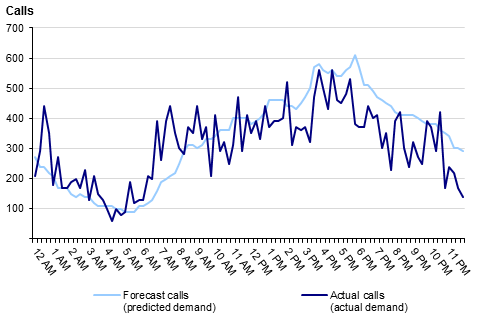
Source: Victorian Auditor-General's Office based on Emergency Services Telecommunications Authority data.
Tuesday 24 June events
A severe weather (wind) event was issued by BOM at 3:30 pm on 23 June for Tuesday 24 June 2014. Damaging wind gusts of 100–125 kilometres per hour (kph) with average winds of 50–70 kph between 6 am and 6 pm were forecast for the South West, Central, West and South Gippsland and East Gippsland forecast districts.
BOM indicated that severe wind gusts in the South West would be early morning and over Central between 7 am and 11 am. They further indicated that a storm surge along the coast was possible.
ESTA again assessed the likely increase in calls for VicSES assistance as approximately 400, based on the similarity of the two BOM forecasts. The difference in actual calls versus predicted calls on 24 June 2014 is shown in Figure C3.
Figure C3
Forecast versus actual calls on 24 June 2014
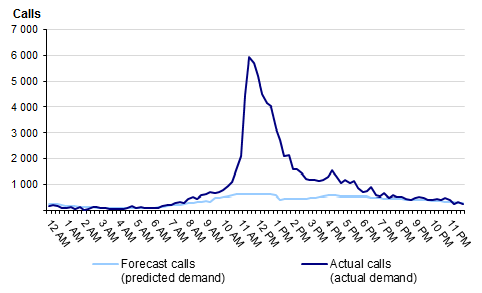
Source: Victorian Auditor-General's Office based on Emergency Services Telecommunications Authority data.
Actions undertaken by ESTA
ESTA undertook a number of key actions in preparation for the storms arrival:
- 8.20 am—storm queue activated by separating the Victoria Police and VicSES queue
- 9.30–11.30 am—ESTA began marshalling additional call-taker resources from scheduled training activities
- 10 am—increased VicSES dispatchers to three positions and then to four at 10.30 am
- 10.50 am—training room (five desks only) converted to live operations
- 11 am—call-taker course recalled providing eight additional call-takers to supplement police and VicSES queues
- 11.10 am—dispatch course members recalled to man positions (four trainees and two trainers)
- 11 am–1 pm—call-taker break time reduced from 30 minutes to 15 minutes
- 11.15 am—off-duty World Trade Centre (WTC) staff directed to Tally Ho Business Park (THO) State Emergency Communications Centre(SECC) to assist with VicSEScall‑taking and dispatch
- 1–2 pm—dispatchers reduced to 15 minute breaks
- 4.30 pm—reduced VicSES dispatcher numbers to three as workload decreased.
VicSES provided Emergency Management Liaison Officers to support the ESTA dispatch process and assist with operational command decisions.
Workstation reconfiguration was undertaken at all three SECCs to accommodate the expected increase in demand:
- an additional six call-takers were allocated to the police queue at the THO SECC using cross-trained Ambulance Victoria (AV) call-takers. AV skilled administration staff were put on AV call-taking to protect that queue
- all Ballarat SECC fire call-takers were put on the VicSES storm queue
- all Victorian fire call-taking was then undertaken at the THO SECC
- the WTC SECC messaged all off-duty staff for assistance at the THO SECC and two additional staff reported for duty.

VicSES incident response centre. Photograph courtesy of VicSES.
Call statistics, 23–24 June 2014
Figure C4 shows the number of calls answered and call queue details for the period 23–24 June 2014. It also shows the extent of the impact of the storm on ESTA operations.
Figure C4
Key call statistics for 23–24 June 2014
|
Total calls input to call queues |
Total calls answered |
Calls answered within the five second performance target |
Average time to answer calls |
|
|---|---|---|---|---|
|
Calls input to police and VicSES queues |
8 071 |
5 901 |
46 per cent |
93 seconds |
|
Calls input to police queue |
3 091 |
2 532 |
65 per cent |
14 seconds |
|
Calls input VicSES queue |
4 980 |
3 369 |
31 per cent |
31 seconds |
Source: Victorian Auditor-General’s Office based on Emergency Services Telecommunications Authority data.
Overall assessment
ESTA's procedures were successfully implemented to manage the storm surge.
Pre-planned processes to stand up additional work stations at all three SECCs worked well and staff call-back and reallocation arrangements were successful, as shown by the fact that ESTA had more staff available than activated workstations.
The transition to the split call-taker queues went well and the management of additional staff and coordination between the three SECCs was good.
Two training rooms—at the WTC and THO SECCs—had been configured for Computer Aided Dispatch 9.1 training and were not useable for this surge. However, a 20 workstation overflow facility at THO SECC was available but not activated.
Not being able to accurately predict the actual number of calls on 24 June was a major issue for ESTA. The BOM severe weather warnings were issued in a timely manner and ESTA knew by mid-afternoon on 23 June that 24 June would be a major problem.
ESTA's ability to predict call demand in such circumstances needs to be reviewed. Given that there were more staff available than workstations, the THO SECC overflow facility could also have been activated.
Appendix D. ESTA performance data
The Emergency Services Telecommunications Authority's (ESTA) performance standards are target standards determined by the Inspector-General for Emergency Management (IGEM) after consultation with each of the emergency services organisations. They include:
- quantitative, or time‑based, standards for call-takers to answer incoming calls and for dispatchers to dispatch the appropriate emergency response vehicle
- qualitative standards which are an assessment of the quality of the information collected by call-takers and provided emergency responders by ESTA's dispatchers.
Appendix A contains a detailed breakdown of the performance standards as determined by IGEM, for each emergency services organisation.
This Appendix focuses on quantitative standards only. Data to measure the quantitative standards is collected in real time on a daily basis and averaged over the month, providing a cumulative result which is reported to IGEM monthly.
Detailed call-taking and dispatch statistics are held in the Computer Aided Dispatch (CAD) database. This Appendix details the performance of ESTA call-takers and dispatchers for police, fire, ambulance and the Victoria State Emergency Service for each month from during the period 1 July 2013 to 30 June 2014.
Police call-taking
Figure D1 shows the ESTA call-taker performance for police across the whole of Victoria. While the performance standard applies only to metropolitan police as there is no standard for answering rural police related calls, the metropolitan standard is applied for comparison purposes.
Figure D1 shows that across Victoria the requirement that 80 per cent of police calls be answered within 5 seconds was achieved in each of the 12 months shown.
Figure D1
Police emergency call-taking performance, July 2013 to June 2014
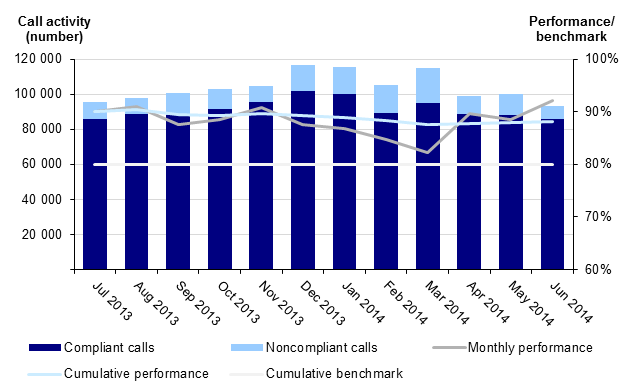
Source: Victorian Auditor-General's Office based on Emergency Services Telecommunications Authority Computer Aided Dispatch data.
Police performance against the standard is shown in Figure D2 which shows ESTA achieved the required benchmarks.
Figure D2
Police call taking performance, July 2013 to June 2014
|
Cumulative result (per cent) |
Metropolitan call‑taking (per cent) |
Rural call‑taking (per cent) |
|
|---|---|---|---|
|
Calls answered within 5 seconds (benchmark 80 per cent) |
88.2 |
88.1 |
88.5 |
|
Calls answered within 60 seconds (benchmark 95 per cent) |
98.1 |
98.1 |
98.3 |
Source: Victorian Auditor-Generals Office based on Emergency Services Telecommunications Authority Computer Aided Dispatch data.
Police dispatch
The required police dispatch performance standard is for 80 per cent of events to be dispatched within 160 seconds and 90 per cent of dispatches within 240 seconds of the event being accepted.
Figure D3 shows ESTA's performance for the dispatch of police Priority 1 events across Victoria. Monthly performance was above the required 80 per cent over the period of July 2013 to June 2014.
Figure D3
Police statewide Priority 1 event dispatch performance, July 2013 to June 2014
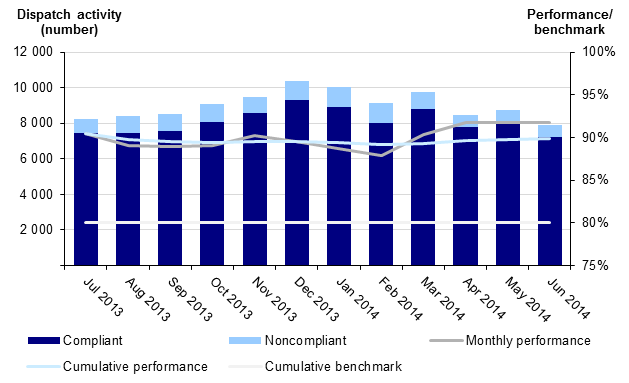
Source: Victorian Auditor-General's Office based on Emergency Services Telecommunications Authority Computer Aided Dispatch data.
The analysis of dispatch performance in Figure D4 shows that—when broken into metropolitan and rural—ESTA met both the required performance objectives.
Figure D4
Police dispatch performance, July 2013 to June 2014
|
Cumulative result |
Metropolitan dispatch (per cent) |
Rural dispatch (per cent) |
Statewide (per cent) |
|---|---|---|---|
|
Priority 1 |
89.5 |
91.4 |
89.9 |
|
Priority 2 |
86.8 |
91.5 |
88.0 |
|
Priority 3 |
98.1 |
98.4 |
98.1 |
Source: Victorian Auditor-General's Office based on Emergency Services Telecommunications Authority Computer Aided Dispatch data.
Ambulance call taking
As with police, ambulance performance standards apply only to metropolitan ambulance calls as there is no standard for answering rural ambulance related calls. IGEM use the metropolitan standard for comparison purposes.
Emergency calls
Figure D5 shows ESTA's state-wide call-taking performance for Emergency (ERTCOM) calls. The required performance standard is that 90 per cent of calls be answered within five seconds and the graph shows that ESTA met this in eleven out of the twelve months. There was no difference in answer times for metropolitan or rural calls.
Figure D5
Ambulance ERTCOM statewide emergency call-taking performance, July 2013 to June 2014
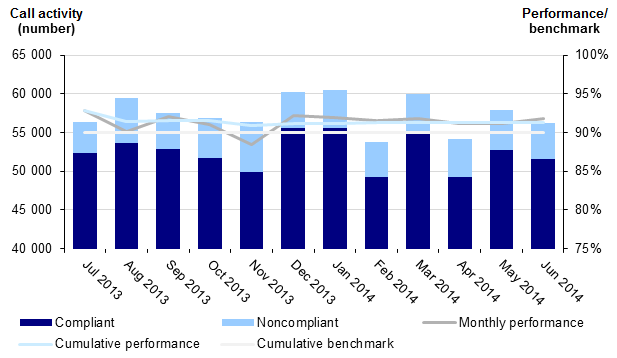
Source: Victorian Auditor-General's Office based on Emergency Services Telecommunications Authority Computer Aided Dispatch data.
![Image shows a MICA paramedic vehicle. Photograph courtesy of Richmeister at en.wikipedia [CC-BY-SA-3.0
(http://creativecommons.org/licenses/by-sa/3.0)
or GFDL
(http://www.gnu.org/copyleft/fdl.html)], from Wikimedia Commons.](/reportAssets/20141014-Emergency-ICT/Image14.png)
Photograph courtesy of Richmeister at en.wikipedia [CC-BY-SA-3.0 (http://creativecommons.org/licenses/by-sa/3.0) or GFDL (http://www.gnu.org/copyleft/fdl.html)], from Wikimedia Commons.
Non-emergency calls
Figure D6 shows the call-taking performance for non-emergency (NETCOM) calls. The required performance standard is that 90 per cent of calls be answered within 30 seconds. The Figure D6 shows that ESTA's performance in answering NETCOM calls consistently exceeded the performance target in each month of the period shown. Responses to metropolitan calls met performance standards on 95 per cent of occasions and rural calls were 94.4 per cent met.
Figure D6
Ambulance NETCOM statewide non-emergency call-taking performance, July 2013 to June 2014
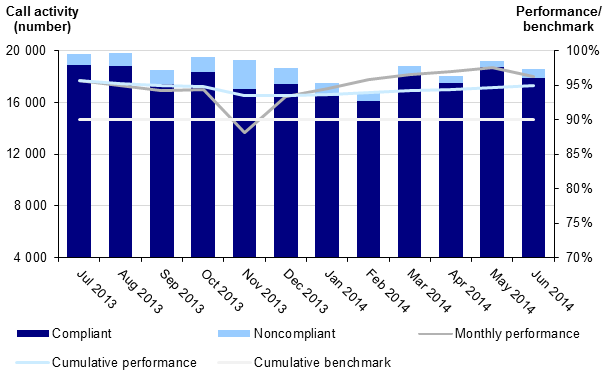
Source: Victorian Auditor-General's Office based on Emergency Services Telecommunication Authority Computer Aided Dispatch data.
Ambulance dispatch
Figure D7 illustrates ESTA's call-taking performance for the dispatch of Code 1 events in rural areas. Again, there is no performance target for rural ambulance dispatch and the metropolitan standard is used by IGEM for comparison purposes. The performance standard is for 90 per cent of events to be dispatched within 150 seconds.
Figure D7 shows that rural dispatch performance targets are consistently being achieved as the 90 per cent benchmark was exceed in each month of the period shown.
Metropolitan dispatch data analysed for this audit shows that ESTA consistently misses the metropolitan Code 1 response target and has done so in each month since January 2011. Over the period July 2013 to June 2014, ESTA averaged only 77 per cent of metropolitan dispatches within 150 seconds.
Figure D7
Ambulance ERTCOM rural Code 1 event dispatch performance, July 2013 to June 2014
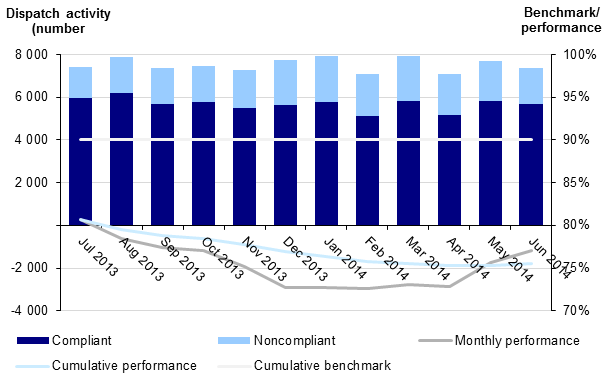
Source: Victorian Auditor-General's Office based on Emergency Services Telecommunications Authority Computer Aided Dispatch data.
Fire call-taking
Figure D8 shows ESTA's call taking performance for emergency calls for Country Fire Authority (CFA) assistance.
The dark grey line shows performance for each of the 12 months in the period July 2013 to June 2014, and shows that ESTA missed its performance standard for January and February 2014. In other months the target was exceeded. The CFA standard is that 90 per cent of calls are answered within five seconds over the month.
Figure D8
Country Fire Authority emergency call taking performance, July 2013 to June 2014
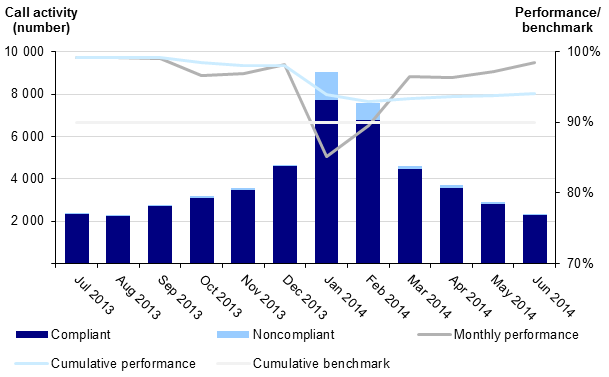
Source: Victorian Auditor-General's Office based on Emergency Services Telecommunications Authority Computer Aided Dispatch data.
Figure D9 shows ESTA's call-taking performance for emergency calls for Metropolitan Fire and Emergency Services Board (MFB) assistance.
The dark grey line shows performance for each of the 12 months in the period July 2013 to June 2014, and shows that ESTA missed its MFB performance standard for January and February 2014. In other months the target was exceeded. The MFB standard is that 90 per cent of calls are answered within five seconds over the month.
Figure D9
Metropolitan Fire Board emergency call taking performance, July 2013 to June 2014
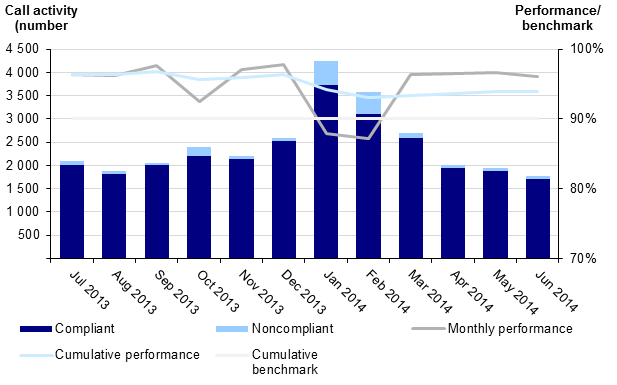
Source: Victorian Auditor-General's Office based on Emergency Services Telecommunications Authority Computer Aided Dispatch data.
Fire dispatch
Figure D10 shows that ESTA's statewide performance for Priority 1 for dispatches across Victoria, including both CFA and MFB. The required performance standards are complex with dispatch times dependent on the location of the event.
Figure D10
Fire dispatch performance variations
|
MFB |
CFA – rural areas other than towns |
CFA – rural towns |
|
|---|---|---|---|
|
Dispatch emergency events |
90 per cent within |
90 per cent within 190 seconds |
90 per cent within |
|
Dispatch automatic alarms |
90 per cent within |
90 per cent within 28 seconds |
90 per cent within |
Source: Victorian Auditor-General's Office.
Figure D11 shows that monthly performance fell below the required 90 per cent in December 2013 and recovered in March 2014, which was due to extensive fire and storm events during January and February 2014.
Figure D11
Monthly CFA Priority 1 dispatch performance July 2013 to June 2014
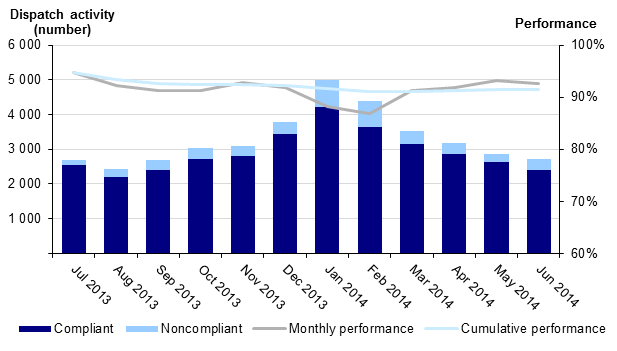
Note: The benchmarks are as detailed in Figure D10.
Source: Victorian Auditor-General's Office based on Emergency Services Telecommunications Authority Computer Aided Dispatch data.
Appendix E. Acronyms used in this report
List of acronyms
AV |
Ambulance Victoria |
AVL |
Automatic Vehicle Location |
BAL SECC |
Emergency Services Telecommunications Authority State Emergency Communications Centre located at Ballarat |
CAD |
Computer Aided Dispatch |
CFA |
Country Fire Authority |
DEPI |
Department of Environment and Primary Industries |
DOH |
Department of Health |
DOJ |
Department of Justice |
EAS |
Emergency Alerting System |
EMC |
Emergency Management Commissioner |
EMV |
Emergency Management Victoria |
ESO |
Emergency services organisation |
ESTA |
Emergency Services Telecommunications Authority |
GSM |
Global System for Mobile Communications |
ICT |
Information and communications technology |
IGEM |
Inspector-General for Emergency Management |
KPI |
Key performance indicator |
LEAP |
Law Enforcement Assistance Program |
MDN |
Mobile Data Network |
MDT |
Mobile Data Terminal |
MFB |
Metropolitan Fire and Emergency Services Board |
MMR |
Metropolitan Mobile Radio |
OESC |
Office of the Emergency Services Commissioner |
PSO |
Protective services officer |
RMR |
Rural Mobile Radio |
SECC |
State Emergency Communications Centre |
SMR |
StateNet Mobile Radio |
THO SECC |
Emergency Services Telecommunications Authority State Emergency Communications Centre located at Tally Ho Business Park |
UHF |
Ultra-high frequency |
VHF |
Very-high frequency |
VicPol |
Victoria Police |
VicSES |
Victoria State Emergency Service |
WTC SECC |
Emergency Services Telecommunications Authority State Emergency Communications Centre located at World Trade Centre |
WAN |
Wide area network |
Appendix F. Audit Act 1994 section 16—submissions and comments
Introduction
In accordance with section 16(3) of the Audit Act 1994, a copy of this report, or part of this report, was provided t the 11 audited agencies.
The submissions and comments provided are not subject to audit nor the evidentiary standards required to reach an audit conclusion. Responsibility for the accuracy, fairness and balance of those comments rests solely with the agency head.
Responses were received as follows:
- Ambulance Victoria
- Country Fire Authority
- Department of Environment and Primary Industries
- Department of Health
- Department of Justice, incorporating the Emergency Management Victoria and the Inspector-General for Emergency Management responses
- Emergency Services Telecommunications Authority
- Metropolitan Fire and Emergency Services Board
- Victoria Police
- Victoria State Emergency Service.
RESPONSE provided by the Chief Executive Officer, Ambulance Victoria
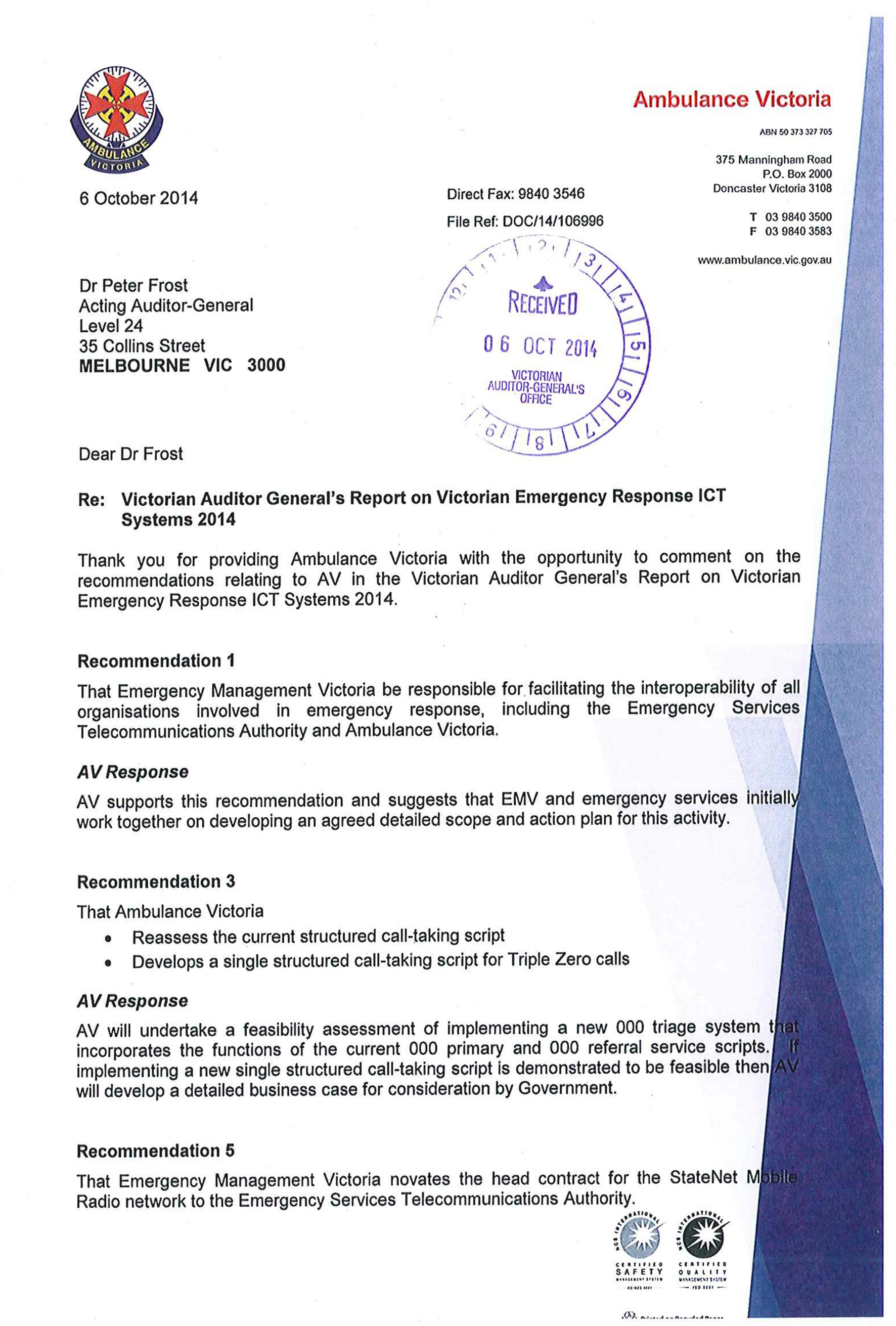
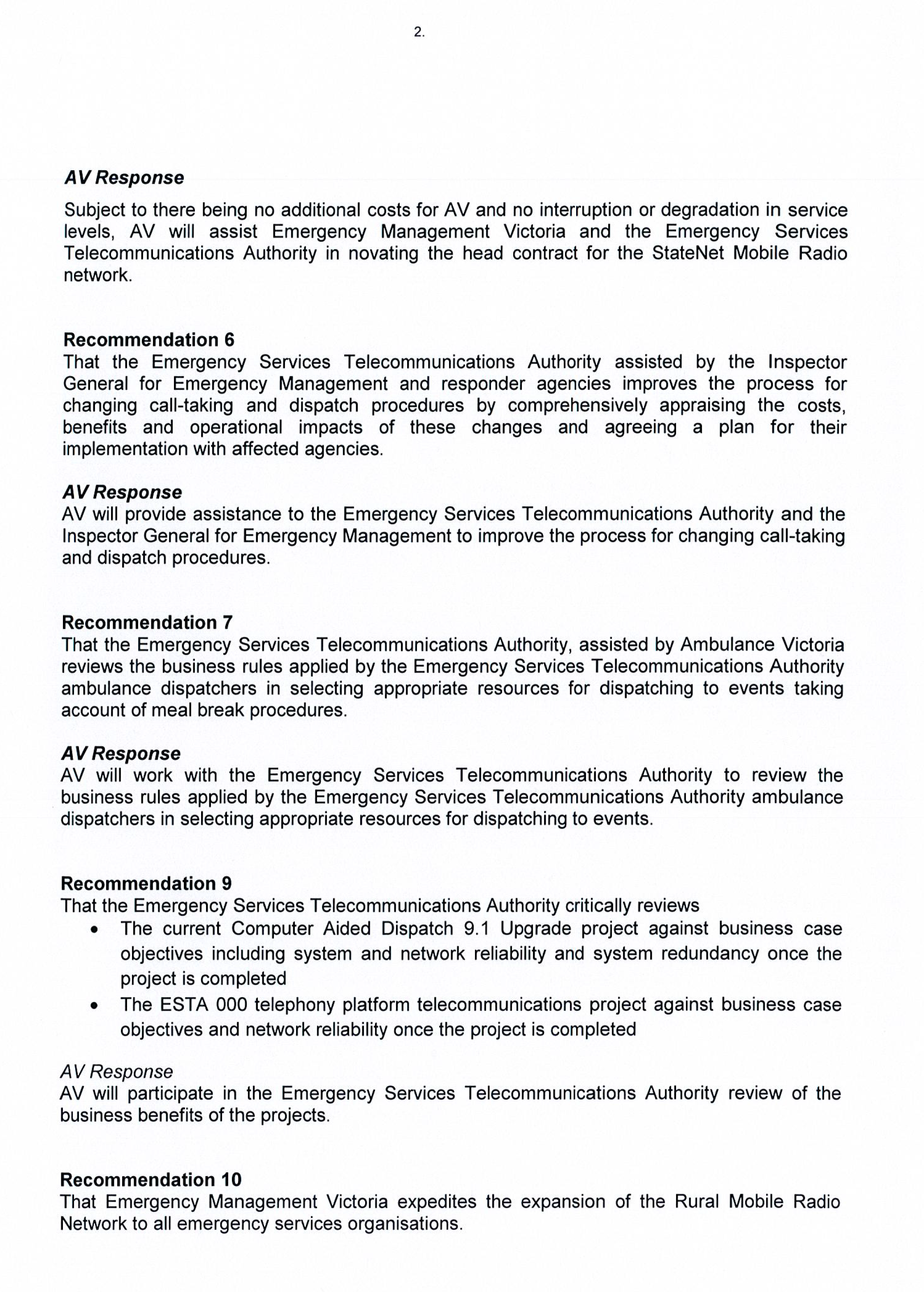
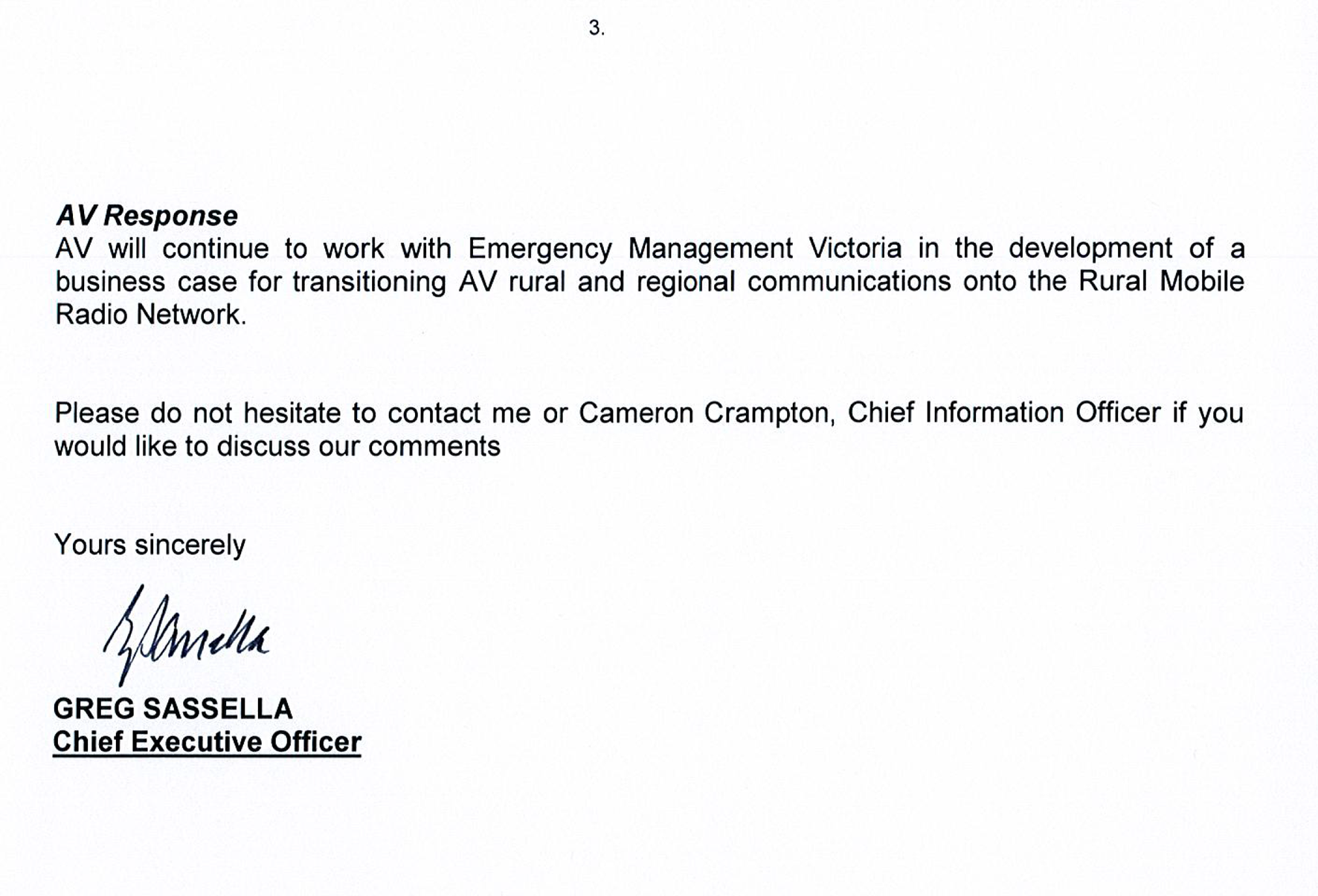
RESPONSE provided by the Acting Chief Executive Officer, Country Fire Authority

RESPONSE provided by the Secretary, Department of Environment and Primary Industries
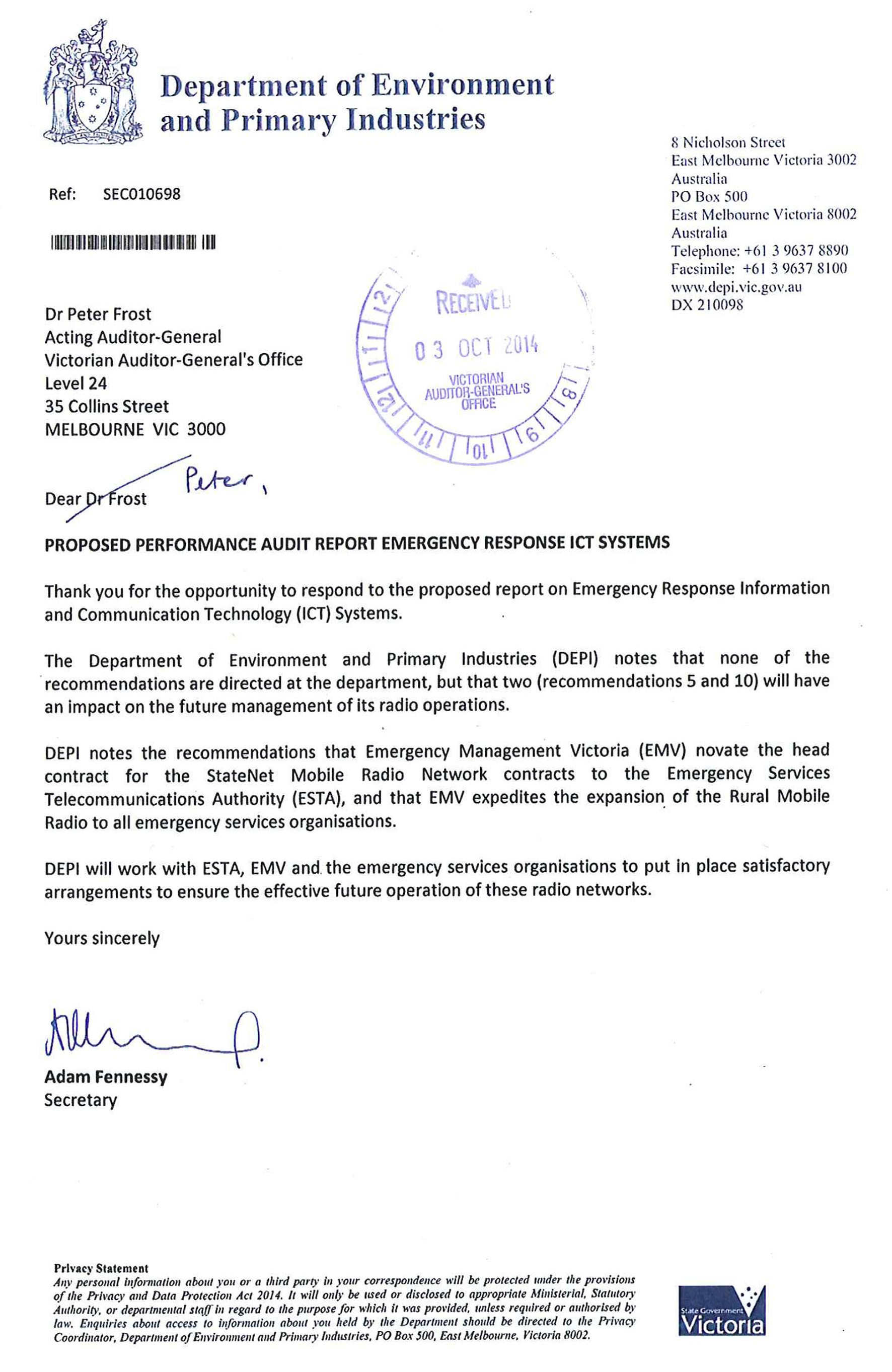
RESPONSE provided by the Secretary, Department of Health
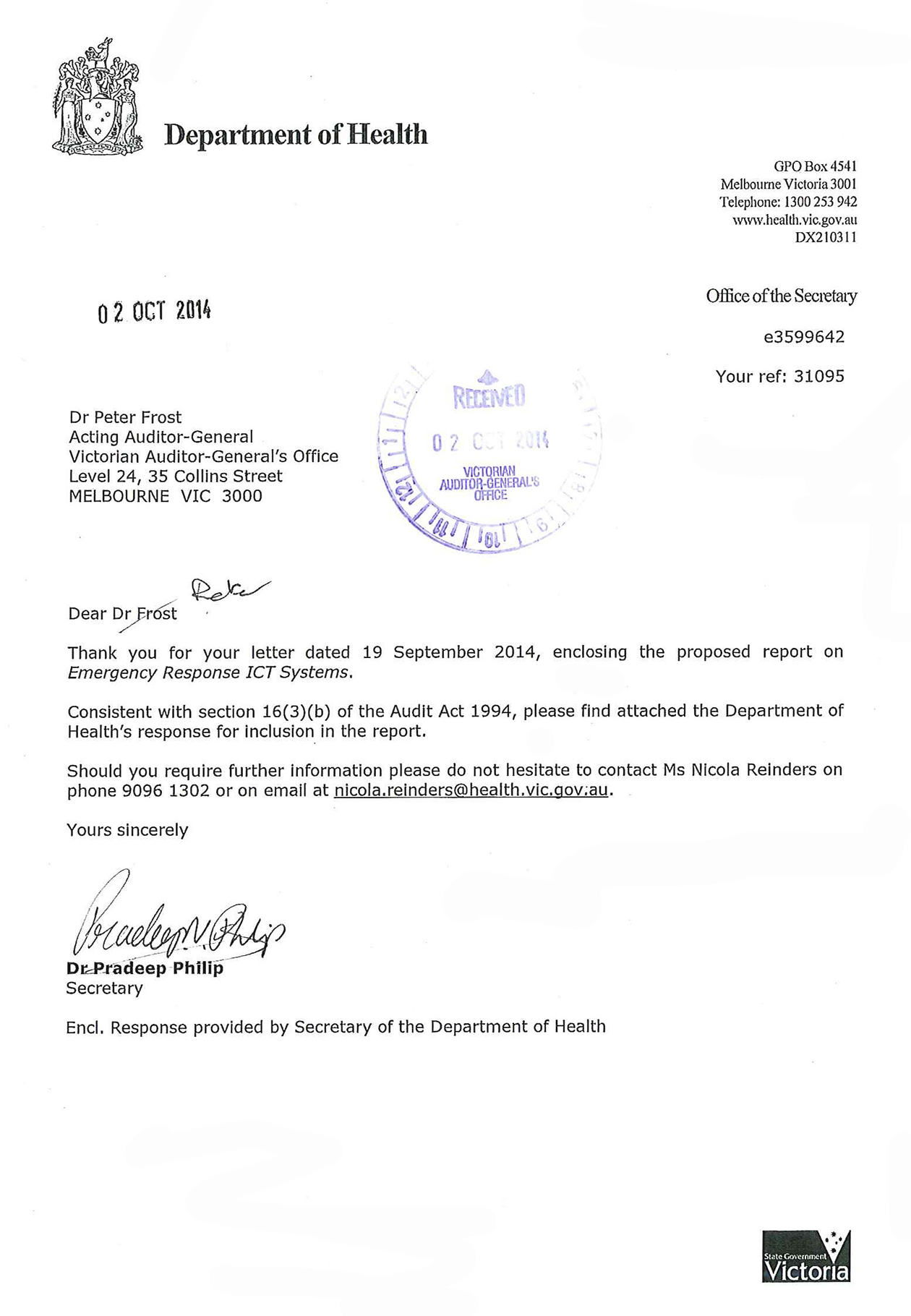
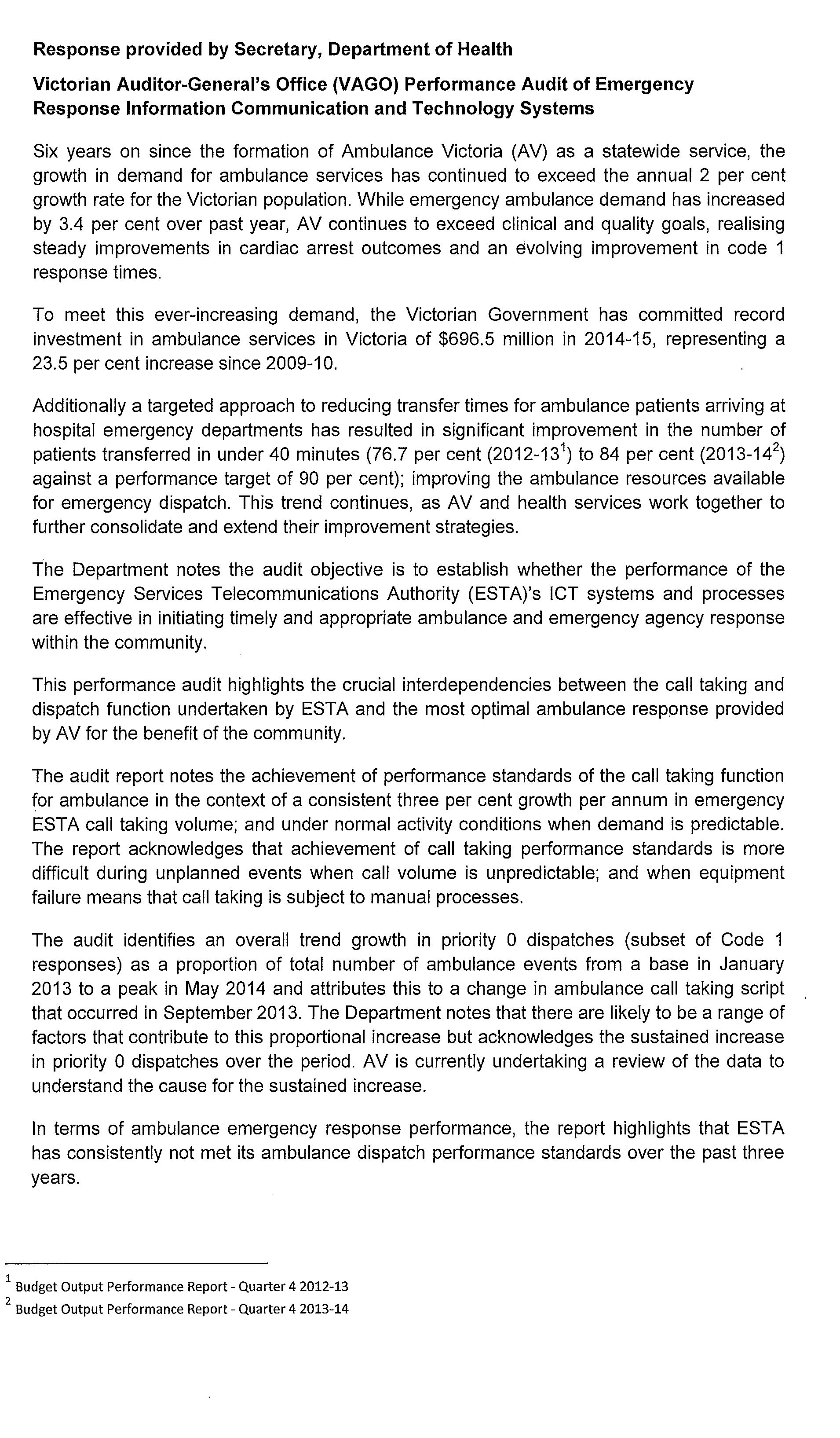
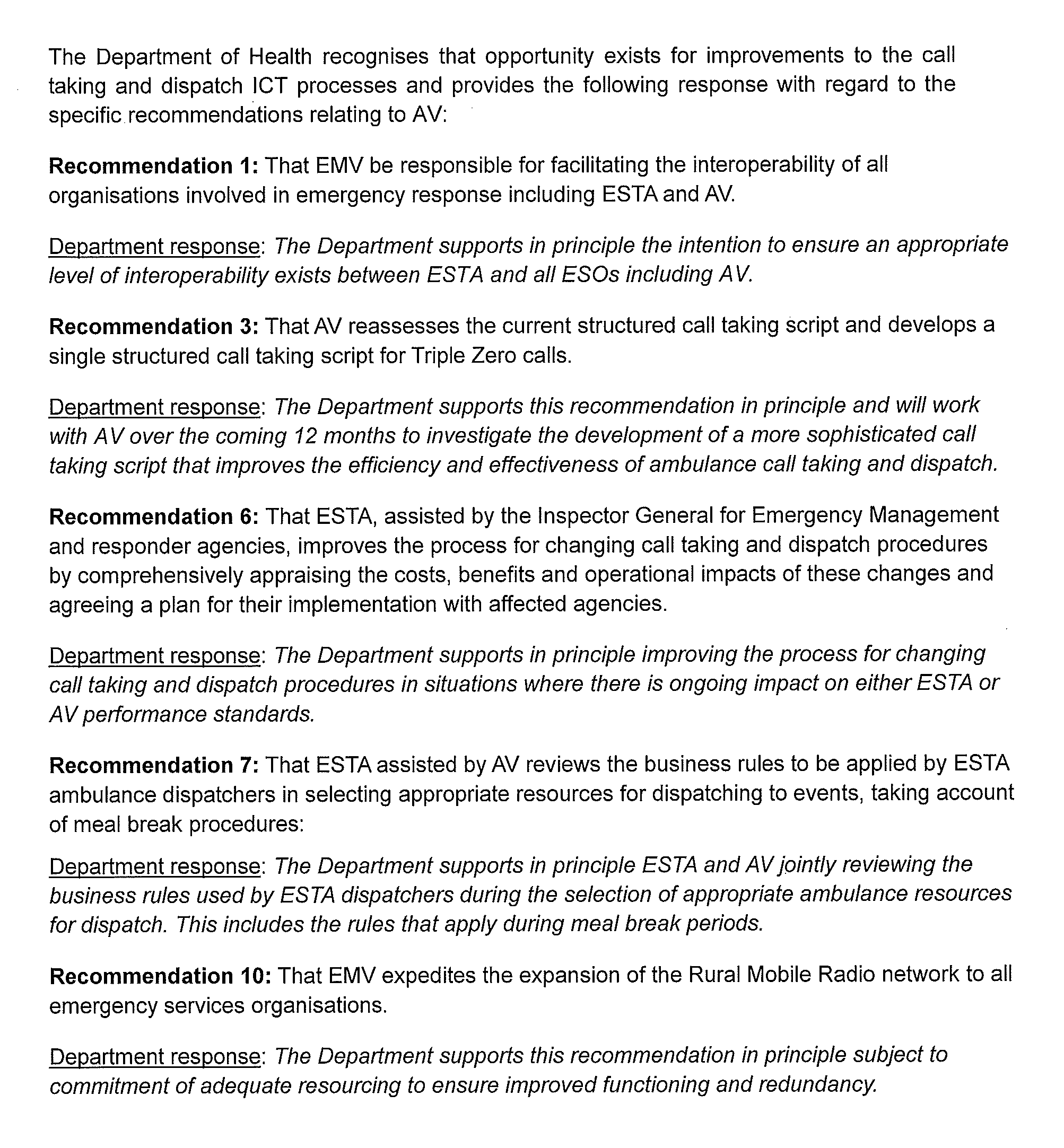
RESPONSE provided by the Secretary, Department of Justice
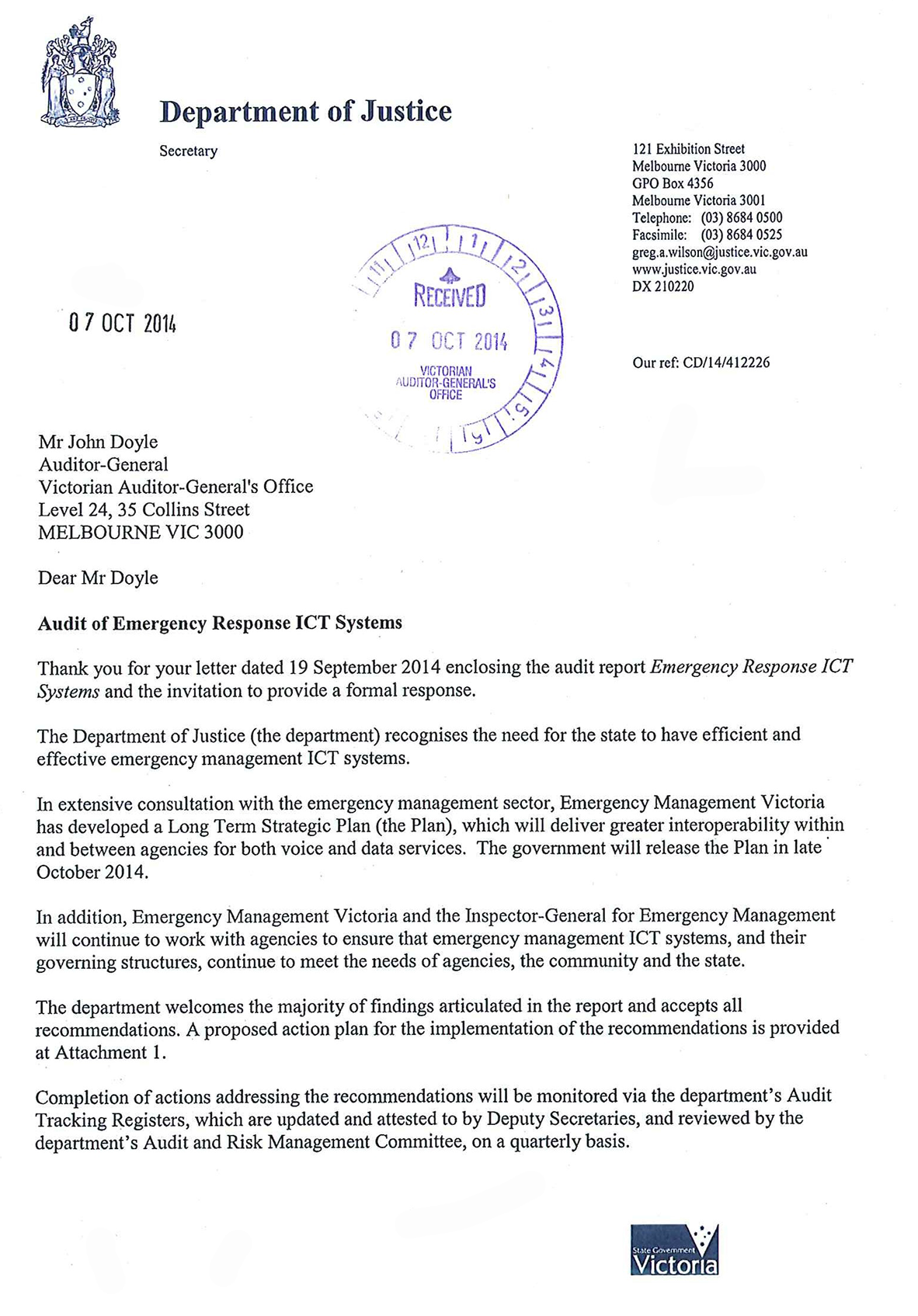

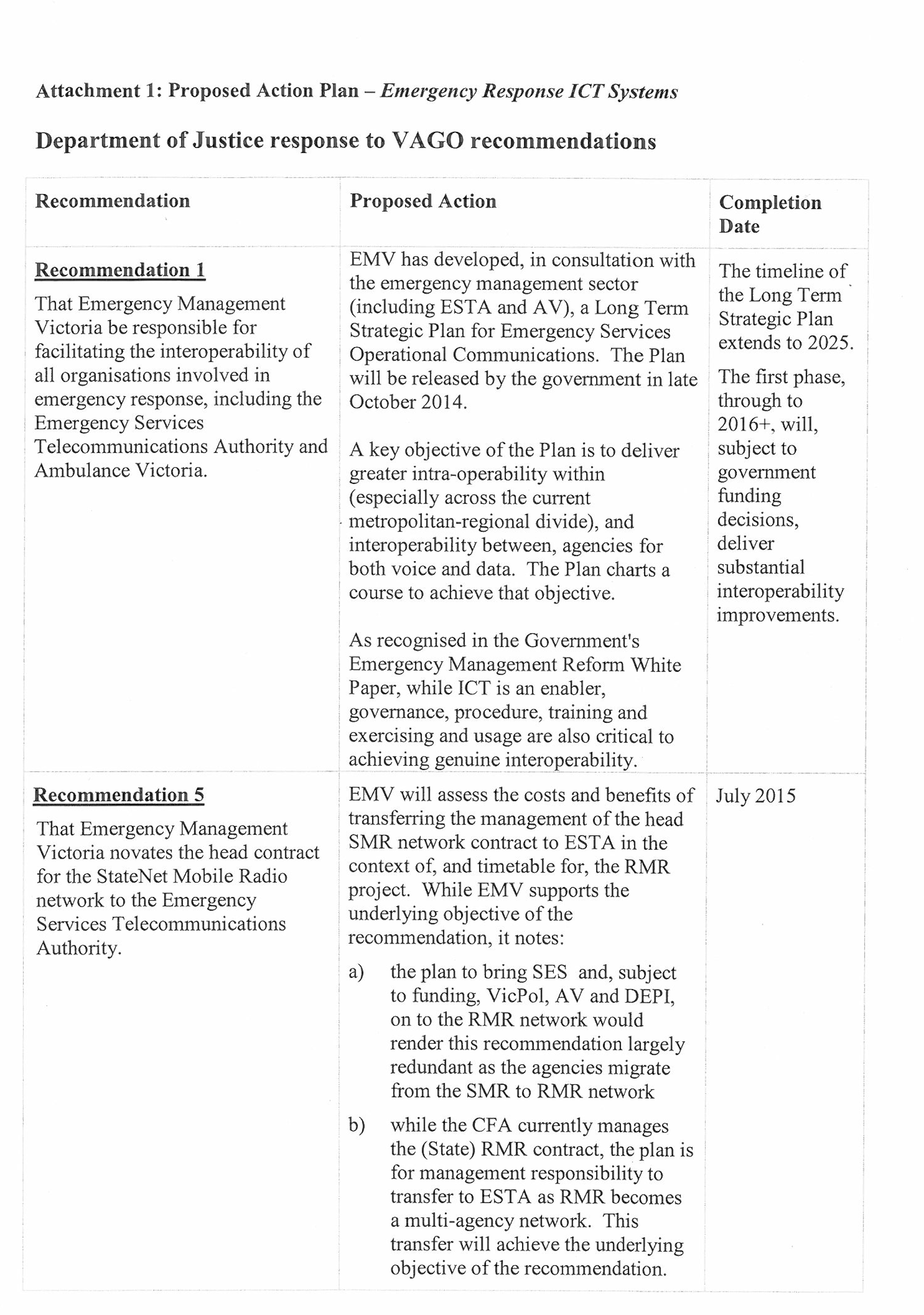
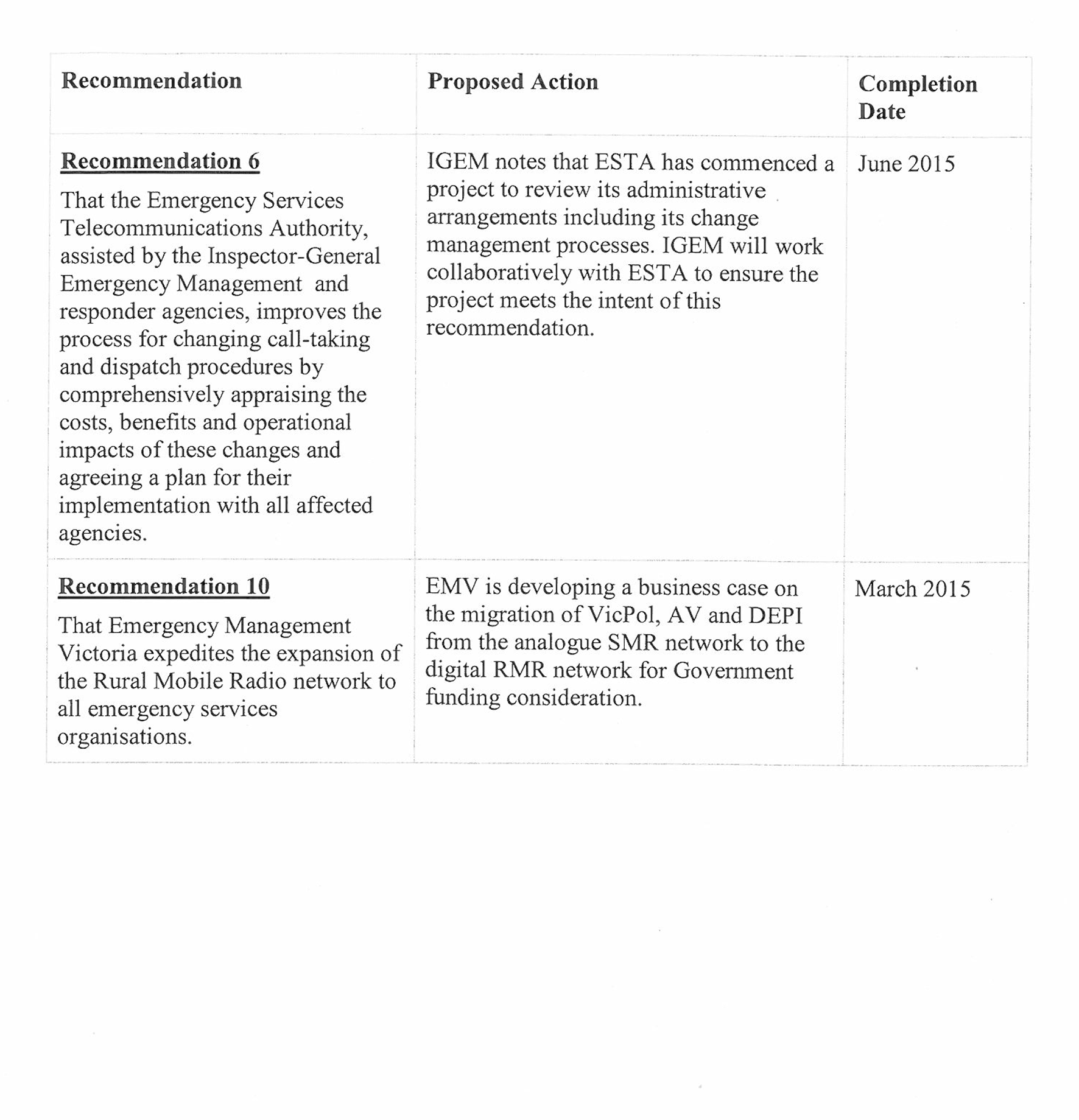
RESPONSE provided by the Chairman, Emergency Services Telecommunications Authority
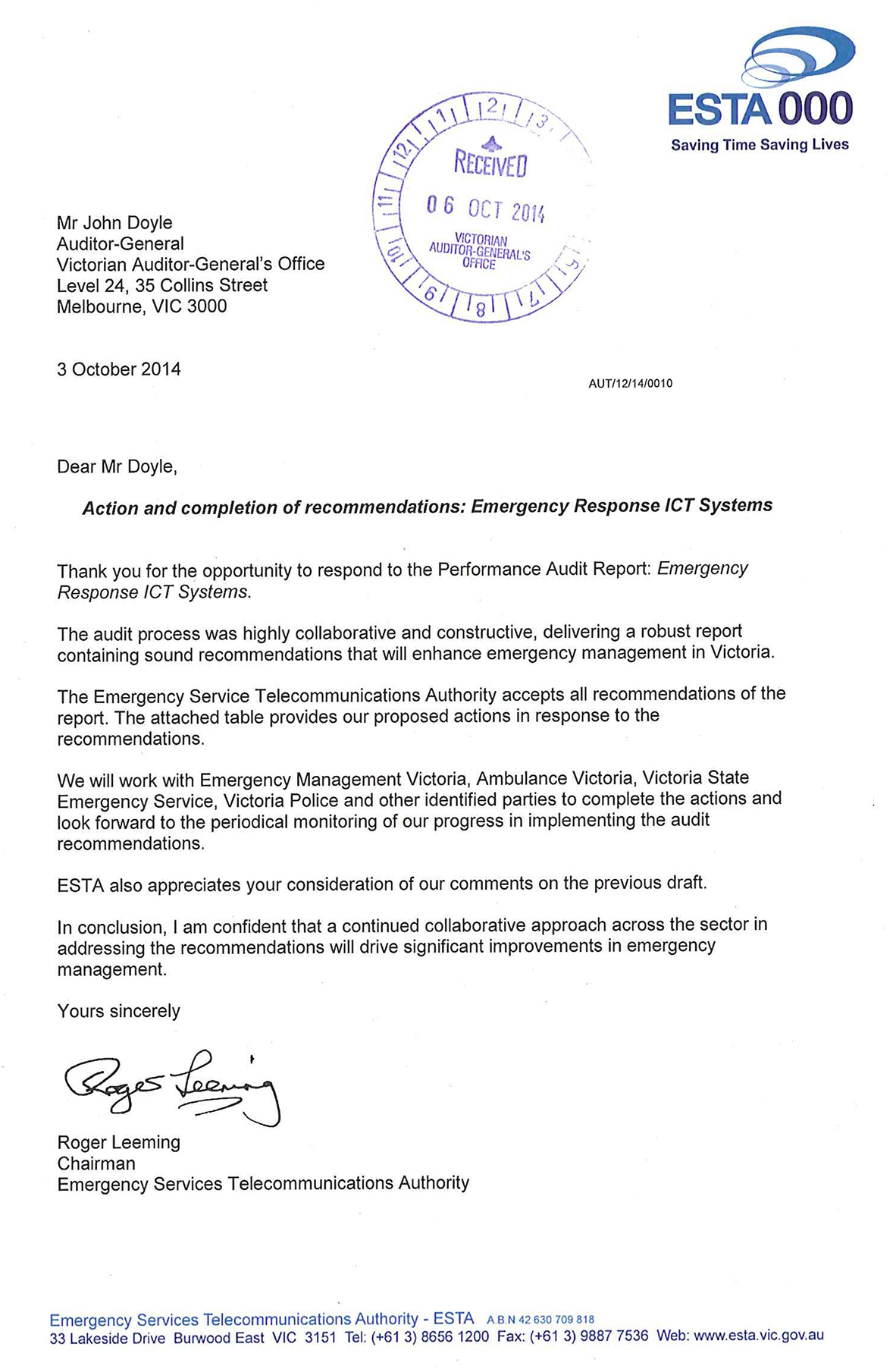
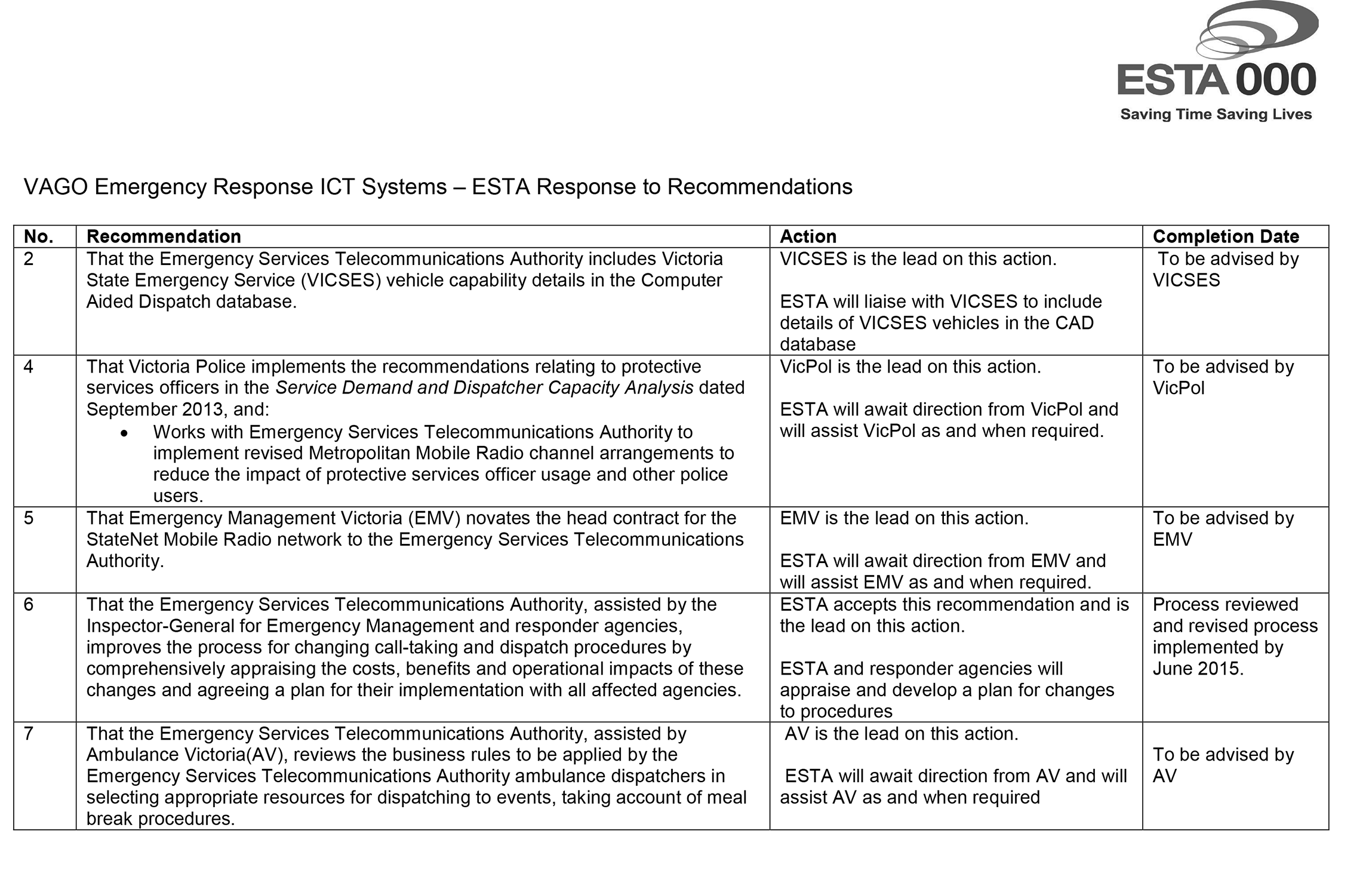
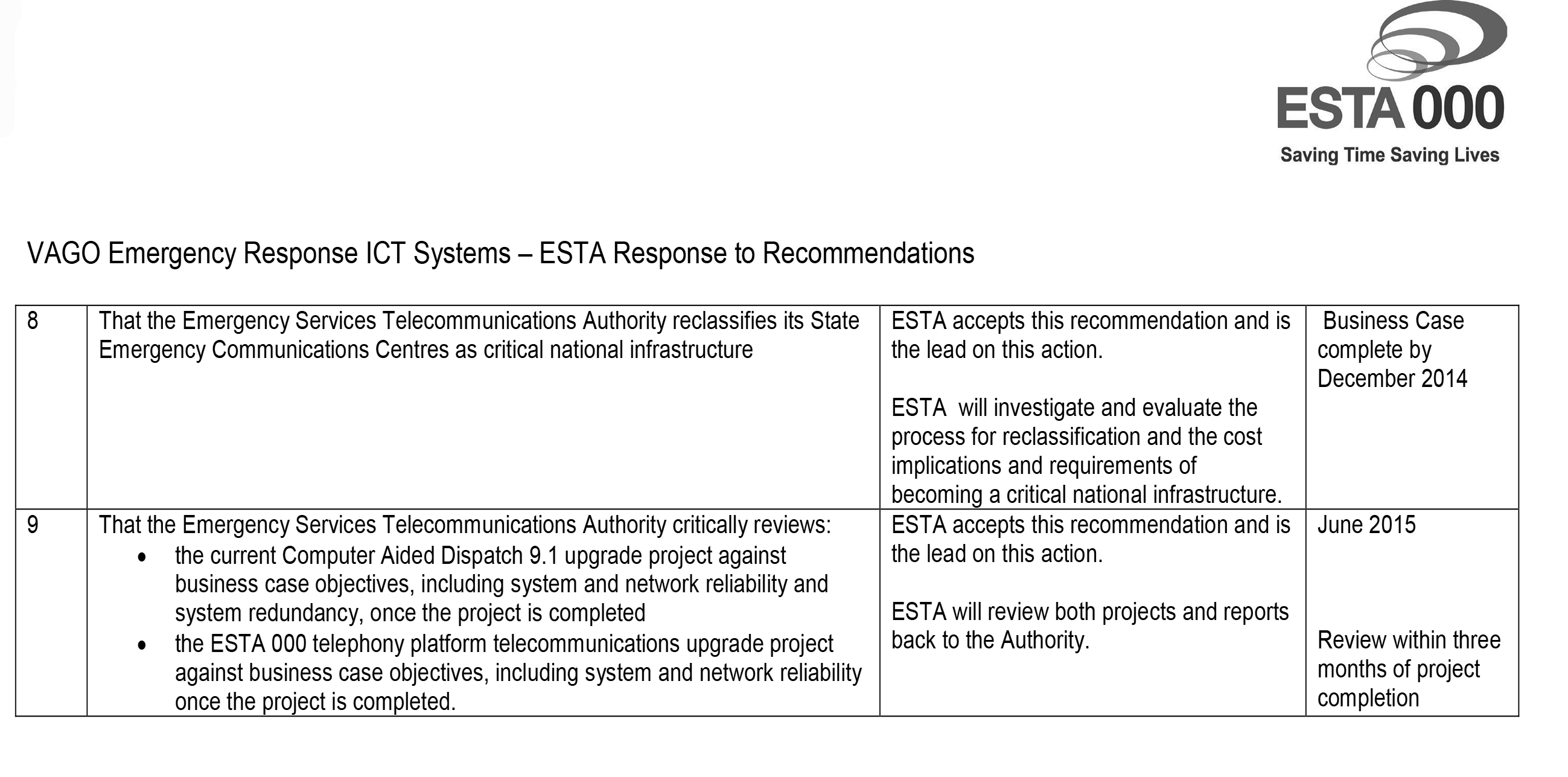
RESPONSE provided by the Executive Director Corporate Services, Metropolitan Fire and Emergency Services Board
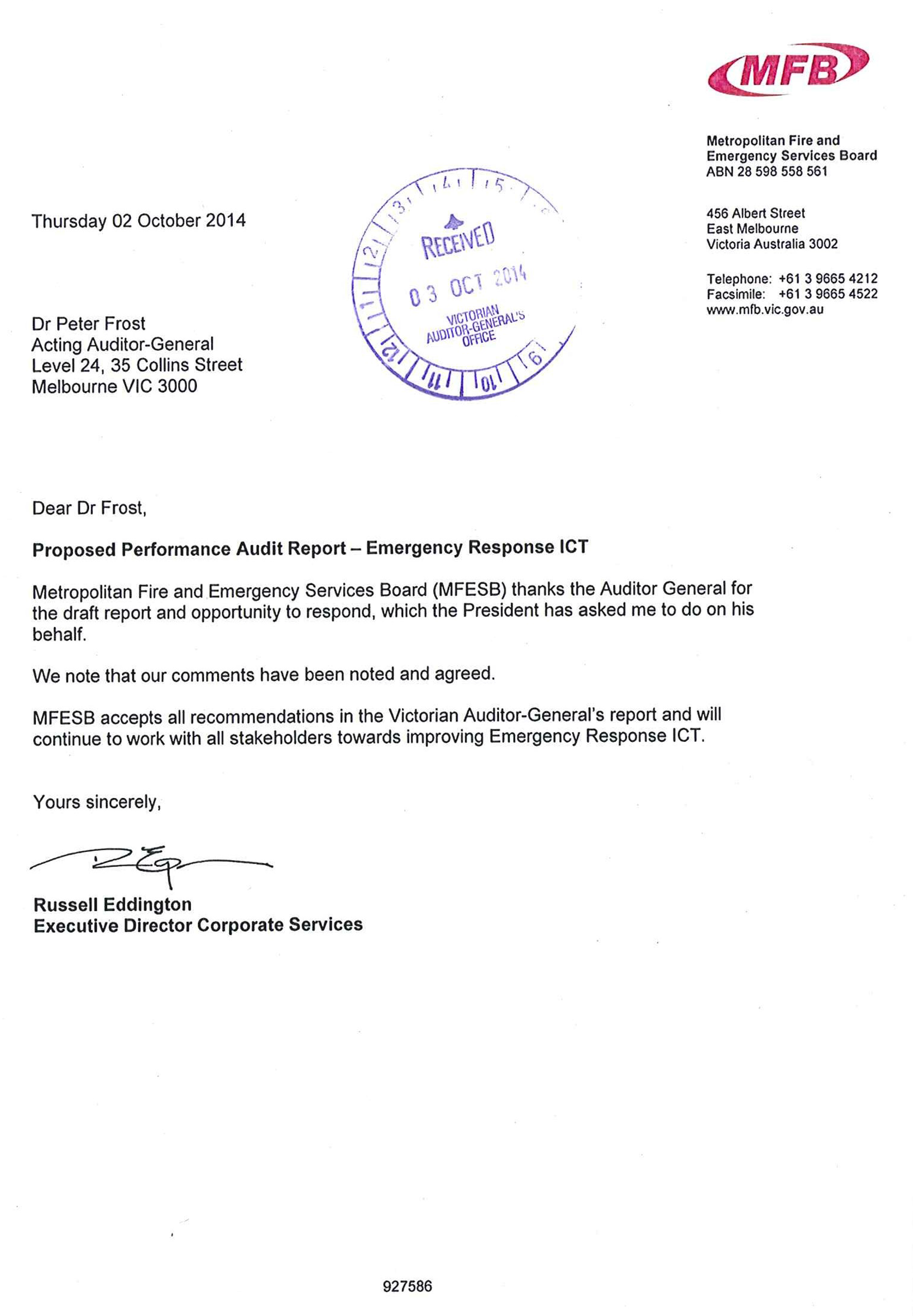
RESPONSE provided by the Assistant Commissioner, State Emergencies and Security Command, Victoria Police
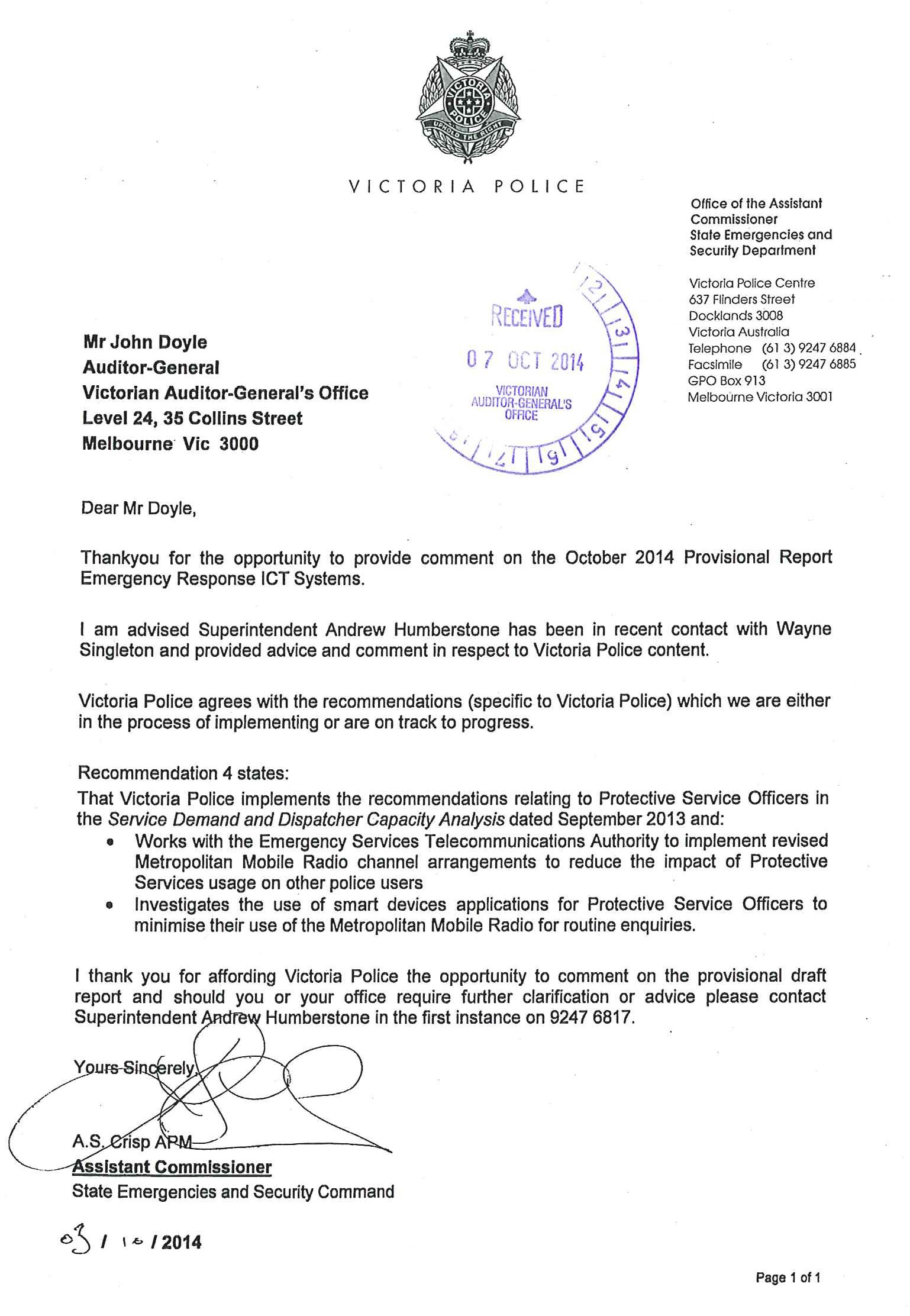
RESPONSE provided by the Chair, Victoria State Emergency Services Authority
